No products in the cart.
Yacon (Smallanthus sonchifolius)
Overview
- Yacon is a sunflower relative from the highlands of the Andes that makes large, edible storage roots.
- This crop is easy to grow in the Pacific Northwest and in much of the rest of the country as well.
- The storage roots can reach sixteen inches or more in length and can weigh more than six pounds, although most are smaller.
- Twenty to thirty pound yields per plant are common in the Pacific Northwest.
- Storage roots are mildly sweet, crisp, and juicy and are usually eaten raw like a fruit.
- Roots are very low in calories because most of the carbohydrate is in the form of indigestible fructooligosaccharide (FOS), which functions as a prebiotic.
- Plants can be grown successfully in most parts of the United States and tolerate more heat than most Andean crops.
- Yacon varieties are clones and plants are normally started by planting pieces of the crown rhizome or from cuttings.
- Plants are generally pretty resistant to pests and diseases, although common sunflower pests can cause problems.
This guide provides information about growing yacon in North America, and particularly the Pacific Northwest, which is the only place that I have experience growing it. Much of the information will apply anywhere, but considerations about the timing of planting and harvesting, climate, photoperiod, and pests and diseases will vary considerably by location.
About Yacon
Description
Yacon (also yacón or yakon, Smallanthus sonchifolius; previously Polymnia sonchifolia and P. edulis), pronounced yah-CONE, is a member of the family Asteraceae, a relative of sunflowers, dahlias, Jerusalem artichokes, and many other common edible and ornamental plants. In English, yacon is sometimes called things like Bolivian sunroot, Peruvian ground apple, and the rather romantic, but confusing “yacon strawberry.” I think we’re better off not confusing everyone with new names.
The plant looks generally similar to a sunflower and typically grows 4 to 5 feet (1.2 to 1.5 m) tall, although some varieties may grow as tall as 7 to 8 feet (2.1 to 2.4 m) in the ideal climate. In fact, it is possible that some varieties reach nearly 10 feet (3m) tall (Vitali 2015). We had one seedling in 2016 that reached 8 feet 4 inches (2.54 m). Flowers form between five and nine months after planting, with most varieties starting at about 6 1/2 months. They look like small sunflowers. The edible part of the plant is its cluster of storage roots. The cluster may include more than a dozen large roots, especially if the plant is grown as a perennial. The roots are crisp, very juicy, and mildly sweet and are used more like a fruit than a vegetable. Although they are often referred to as tubers, the edible part of yacon is technically a storage root or tuberous root. The difference is that tubers are anatomically derived from stems, while storage roots are derived from roots. If you call them tubers, nobody is likely to bat an eye, but now you know the difference.
The flavor of yacon is often described as a mixture of things like apple, pear, and celery. It sounds a little strange, but it seems to be uncontroversially tasty. The texture is crisp, a bit like celery without the stringiness. In fact, one of the best features of yacon is that it remains crisp even after being cut or cooked. It also oxidizes at a slow rate, so a bowl of yacon slices made in the morning will still be nearly the same color and just as crisp in the afternoon, or even the next day. Currently the plant is the subject of a lot of health and diet claims, which are probably overblown. Even if they are, who cares? Yacon tastes great. You can grow yacon without too much difficulty in most climates and, until it becomes more popular, that is the only way that most of us can get fresh, unprocessed yacon.
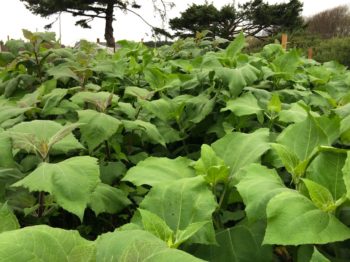 Yacon is usually grown from chunks of rhizome. Like most of the Andean roots and tubers, it is a clonal plant that rarely produces true seed. A single yacon plant can produce enough rhizome to start anywhere from one to sixty new plants, depending on how well the rhizome developed and how many growing points you allocate per chunk of rhizome.
Yacon is usually grown from chunks of rhizome. Like most of the Andean roots and tubers, it is a clonal plant that rarely produces true seed. A single yacon plant can produce enough rhizome to start anywhere from one to sixty new plants, depending on how well the rhizome developed and how many growing points you allocate per chunk of rhizome.
The storage roots of different varieties can be differentiated primarily by skin color, flesh color, and level of sweetness. Skin color ranges from nearly white to purple, but tan is the predominant color. Flesh color is usually white, but may also be partly or entirely light purple or light orange in varieties currently available in North America. There are varieties in the Andes that have pink and yellow flesh as well (NRC 1989). Colors are deeper in fully mature storage roots and following exposure of the roots to sunlight. Sweetness ranges from nearly bland roots that taste very similar to celery at harvest to relatively sweet varieties that approach the lower end of the range of sweetness found in apples. Sweetness increases with post-harvest storage and even more so with exposure to sunlight.
Storage roots can be differentiated by shape, although this is not always reliable because growing conditions have a strong influence on the shape of the roots. Roots may be lemon shaped, pear shaped, reverse pear shaped, spherical, or cylindrical (Polreich 2003). Varieties with pear shaped and spherical roots are easier to harvest in heavy soil without breakage.
The plants differ primarily in height, color of the stem, flower form, and leaf shape. Some varieties have red stems, some green, and others a combination of the two. Some varieties are tall, reaching about 6.5 feet (2 m) here, and others short, reaching about 4 feet (1.2 m). Yield is generally better with taller varieties, although not proportionately so; the difference in yield between a medium and tall variety might be only ten or twenty percent.
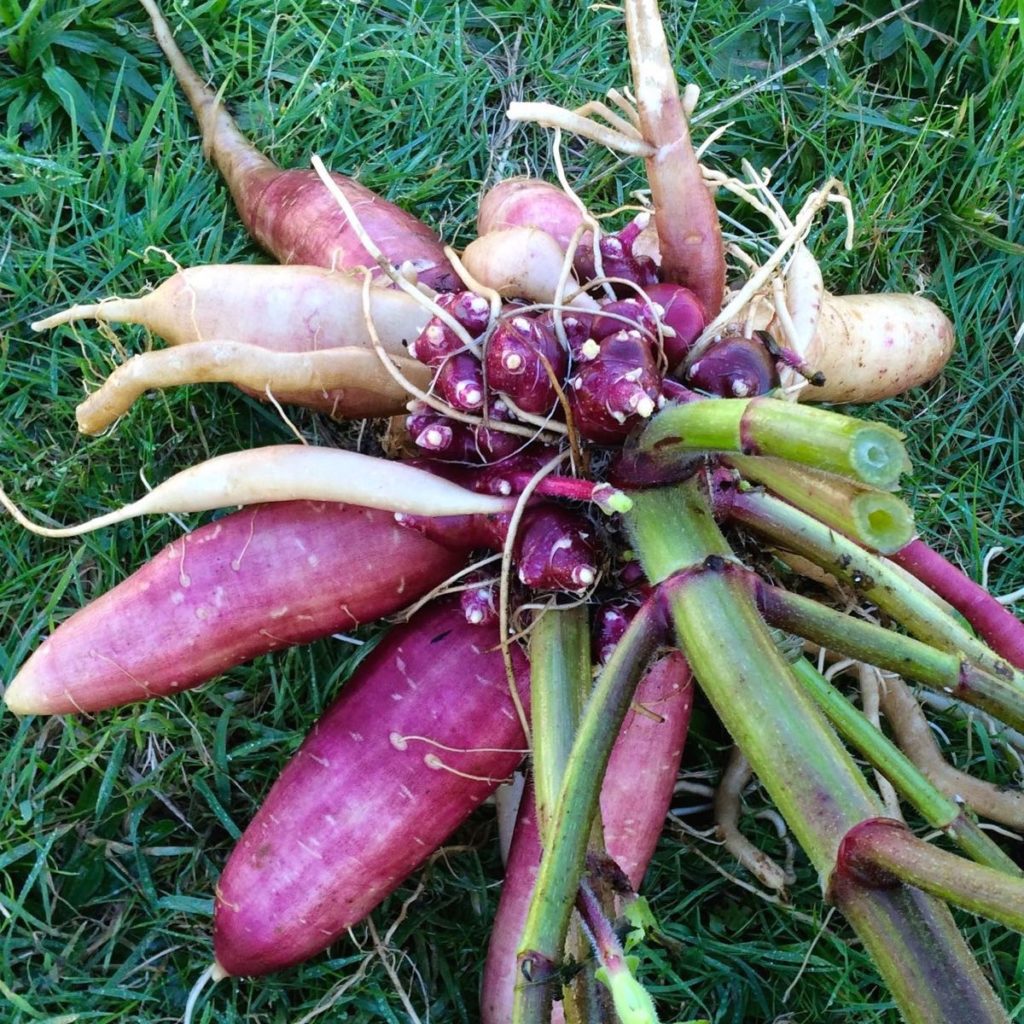
I grow as many varieties as possible in order to supply the maximum possible genetic diversity to our breeding project, but the typical grower will probably see little advantage in growing more than one or two varieties with different skin or flesh colors. If you live in a windy spot, you will probably prefer to grow short varieties. This cuts down on the disappointment of seeing them all lodge in high winds. If you don’t live in a windy spot, then grow a tall variety since the yield will be better. If you like purple, grow a purple variety, but remember that you’re going to skin the yacon and they all look pretty similar after that.
History
Yacon’s native distribution runs through the Andes from Colombia to northern Argentina. It still grows wild in Colombia, Ecuador, and Peru (NRC 1989). It’s native distribution appears to be centered in the Yungas, a region on the eastern slopes of the Andes that is warmer and more humid than the western slopes.
There is evidence of ancient yacon use in the Andes, preceding the Incas, so humans have had a relationship with this plant for thousands of years. It still grows wild in parts of the Andes and it is debatable how much difference there is between wild and cultivated plants. It is possible that existing varieties were originally selected from the wild and propagated as clones ever since.
It doesn’t appear that yacon was grown on a large scale until modern times. At the time of the Spanish conquest, the Incas reportedly used the plant as a source of water for travelers, a use for which is it well suited, given its high water content. It is most often a component of small gardens, adding diversity to the diet, rather than acting as a staple. This makes perfect sense; given its very low calorie content, yacon would not be grown in large quantities by those engaged in subsistence agriculture.
Following the Spanish conquest of the Andes, yacon cultivation declined, particularly through the 20th century. Many varieties were probably lost and the remaining genetic diversity of yacon appears to be low.
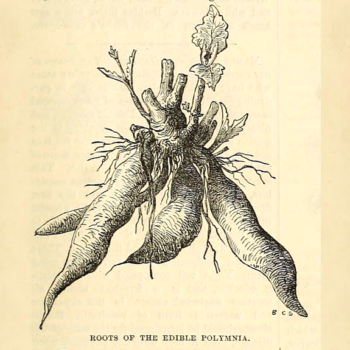
Apparently, yacon was once a common enough feature in northern Argentina for streets and even a town (“Los Yacones”) to be named for it, but cultivation had almost entirely disappeared by the end of the 20th century (Zardini 1991).
Attempts to establish yacon outside the Andes have been mixed. Yacon was first introduced to Germany in 1861 and from there was introduced in the USA in 1869, but, with a few exceptions, it didn’t attract much attention until the 1970s on either side of the Atlantic. An early experiment with yacon in Italy was successful, but discontinued with the onset of World War II (NRC 1989). A single variety from Ecuador was introduced to New Zealand in 1979 (Hermann 2013). In the 1980s and 1990s, yacon was established in Japan, Brazil, South Korea, and the Czech Republic (Hermann 1997). It has since spread around the world and is grown on a small scale in many countries in Europe and North America.
Yacon was initially offered as true seed by the German (then Prussian) seed company Haage and Schmidt, beginning in 1870. It reportedly sold for 4 cents per seed, which would be about 78 cents per seed today accounting for inflation (which is surprisingly close to the price that I set for yacon seed).
Yacon in Japan
Yacon is a now a fairly popular crop in Japan and a large portion of the published work on yacon is available only in Japanese language journals. Varieties have spread from Japan to Korea, China, and possibly SE Asia as well. There are active breeding programs for yacon in Japan, using both laboratory techniques such as mutagenesis and traditional crossing of varieties.
The introduction of yacon to Japan is now literally a textbook case of problems with intellectual property in plant breeding. According to Blakeney (2002), Peru sent several yacon varieties to researchers in Japan, who then produced new varieties. The Japanese researchers then obtained plant breeder’s rights for the new varieties and refused to share them with Peru. This sort of thing is really unfortunate. It has contributed to a bit of a siege mentality within the Andean countries, who now have forbidden distribution of most of their native crops outside of South America.
Japan has introduced at least four new varieties, beginning with ‘Sarada otome’ in 2000, then ‘Andesu no yuki’ and ‘Salad okame’ in 2003, and ‘Andesu no otome’ in 2012. ‘Sarada otome’ resulted from a cross between a Bolivian variety called SY102 and a New Zealand variety called SY12 (Sugiura 2007). ‘Andesu no yuki’ resulted from a cross between the CIP variety CA5073 and a New Zealand variety called SY4. It is a tan-skinned, white flesh variety with large storage roots that resist cracking (Fujino 2007). ‘Salad okame’ resulted from a cross between the CIP variety CA5074 and a Peruvian variety. It has purple skin on exposure (Sugiura 2016), orange flesh, and a high fructooligosaccharide content (Fujino 2007). ‘Andesu no otome’ is a red skinned variety (Sugiura 2016).
Nutrition
Like many of the Andean root and tuber crops, yacon was on a path to increasing obscurity until its potential as a diet food was discovered. When freshly harvested, yacon has very little caloric value; it is mostly water and its energy is largely in the form of fructooligosaccharides (FOS), large sugar molecules that are mostly undigestible by humans. Freshly harvested yacon has about 66 calories per pound (15 calories per 100 g.) After several weeks of storage, the calorie count will go up a bit as some of the undigestible sugars are converted to fructose, rising to at least 100 calories per pound (22 calories per 100 g). Due largely to the fact that it is mostly water, yacon is not particularly rich in vitamins and minerals, although it is a good source of both fiber and potassium, with 180 to 290 mg per 100 gram serving. It is juicy and refreshing, but bulky and slow to digest, just the sort of thing to tide you over without expanding the waistline. Well, except for the gas…
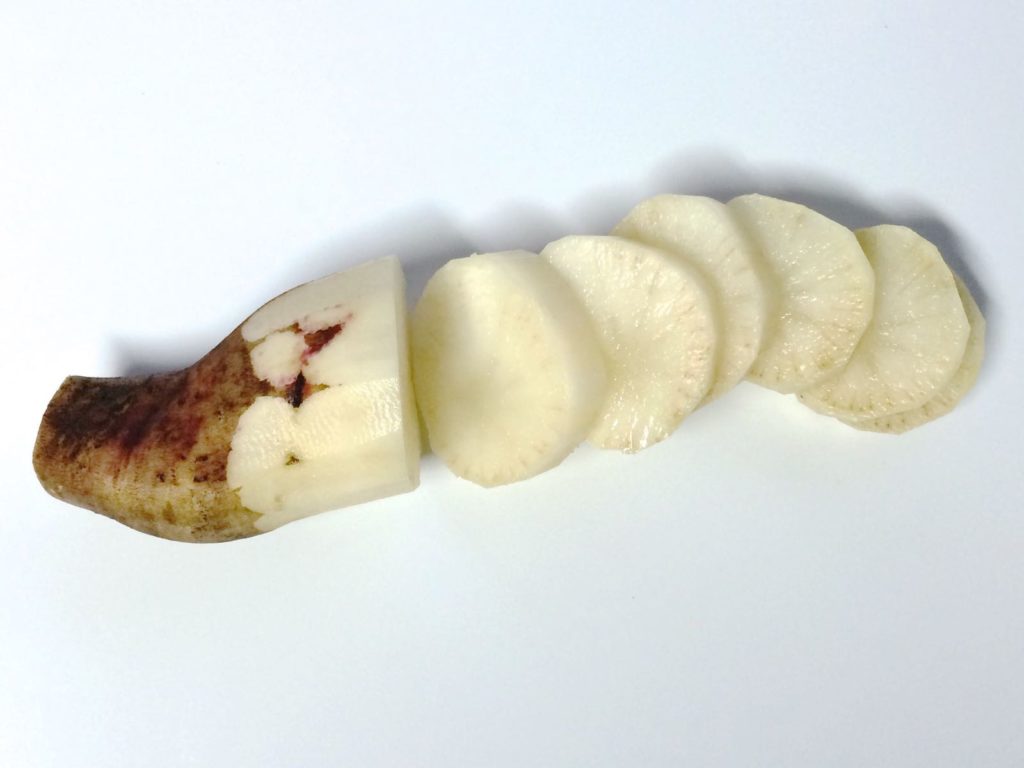
The advantage of the FOS content is that it is not digestible. That is also the disadvantage. The bacteria that live in your gut will have a party when you send some yacon their way and, as the landlord, this can result in some discomfort for you. The situation is similar to that of the more infamous Jerusalem artichoke, which is well known as a gassy vegetable. Jerusalem artichokes contain mostly inulin, a sugar with a high degree of polymerization (Kays 2008) that many people find very difficult to digest, sometimes painfully so. In contrast, yacon contains mostly FOS molecules with a lower degree of polymerization (Hermann 1997); they are still undigestible, but they require less fermentation by bacteria in your gut before they are fully broken down. That means much less gas. Even if you have had trouble with Jerusalem artichokes, you will probably find that you have little difficulty with yacon. Yacon can also have a laxative effect in large doses (Geyer 2008), although I think that, much like the gas, this is a sign of eating too much, too fast, not a consequence of regular yacon consumption. The trick to enjoying yacon is to start slowly.
You may have read that yacon is a good food choice for diabetics. This may be true. It is certainly a better choice than a candy bar. However, I get a little nervous about these claims. After a month of storage, which is the period of time recommended to get the best flavor out of your yacon roots, the fraction of fructose, glucose, and sucrose can increase significantly. One study found that as much as 22% of the dry matter in yacon was fructose and 5% glucose. Another study found that there was greater fructose content than all of the undigestible sugars combined (Ohyama 1990). Be cautious in making assumptions about the sugar content of yacon. This is not to suggest that it isn’t a healthy food, just that you might want to carefully evaluate any claims that sound like hype.
The storage roots can be sweetened by exposing them to sunlight, which results in significant changes in composition in as little as a week. Fructooligosaccharide content declines by anywhere from 10 to 40% and fructose, glucose, and sometimes sucrose increase (Graefe 2004). This is probably desirable for fresh eating, but not for processing into products intended to contain large amounts of FOS.
It is somewhat ironic that the major processed “health” product made from yacon is syrup. Boiling down yacon removes water and concentrates the sugars, but the application of heat also converts a greater portion of those sugars to fructose. There is another high fructose syrup that is commonly available, although it is generally not perceived to be a healthy product: high fructose corn syrup. Is yacon syrup better for you than HFCS? I have no idea. Some would certainly like for you to believe that it is. I would rather slice up a fresh yacon root and enjoy it the way nature made it, although processing into syrup can certainly be a good way to preserve part of a large harvest of yacon. Remember that fructose is exclusively processed in the liver. As I understand it, any excess is converted to localized fat and can contribute to insulin resistance. We didn’t evolve to consume concentrated sources of fructose any more than any other sugar.
In addition to the roots, some sources claim that you can eat the leaves or make a tea from them; however, it is possible that yacon foliage may be toxic to the kidneys (de Oliveira 2010). A more recent study found no negative effects at concentrations likely to be used in tea (Barcellona 2012). I recommend that you don’t eat the leaves or at least limit your consumption until the matter becomes clearer, depending on your appetite for risk. The storage roots appear to be very safe, with no adverse effects found in rats that were fed amounts far in excess of what humans would ever consume (Genta 2009).
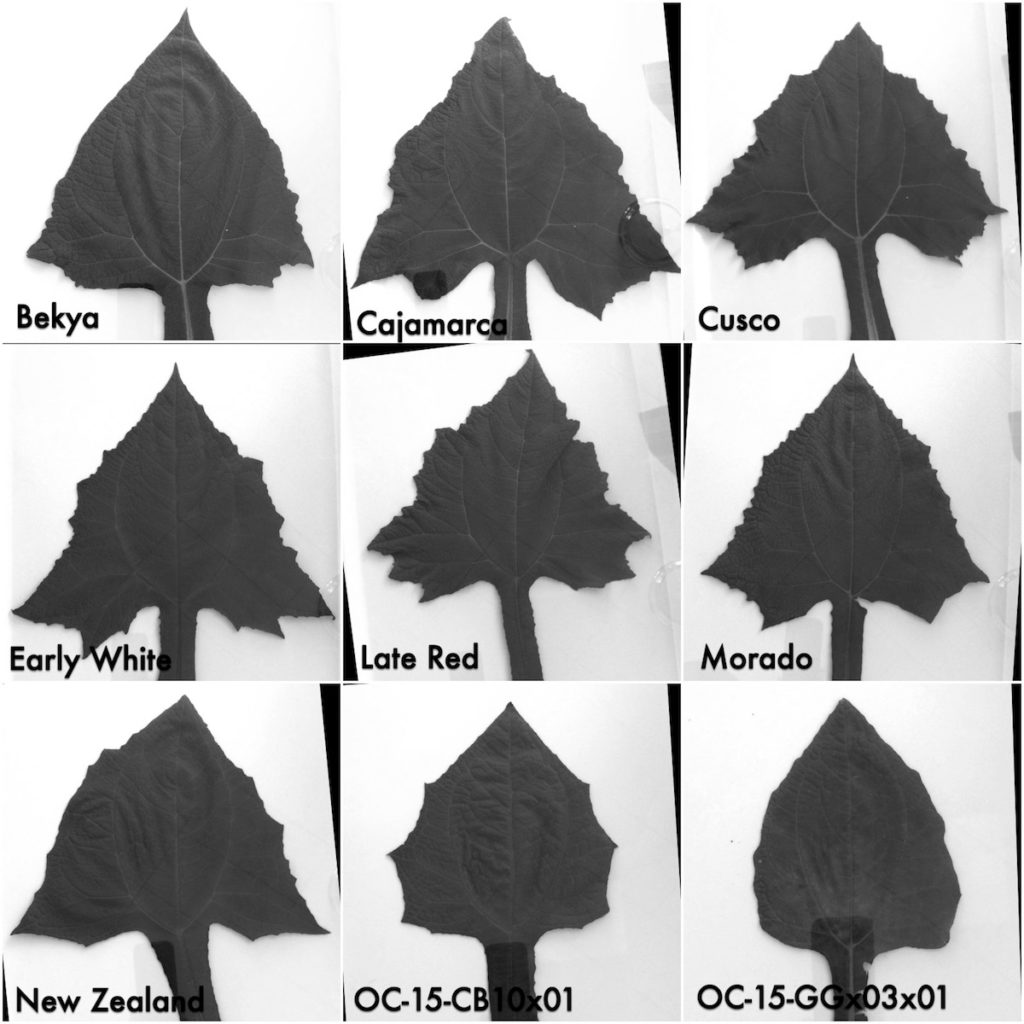
The rhizome is edible, but it doesn’t sweeten as much as the storage roots do and is sometimes fibrous. The bitter skin is difficult to remove due to the convolutions. As a result, almost nobody eats yacon rhizome, but it is possible. It can be used as animal feed; our geese love it.
Dodecaploid varieties have higher fructooligosaccharide content (Fernandez 2013) and therefore may taste sweeter than octoploid varieties.
There has been at least one documented case of anaphylactic reaction to consumption of yacon (Yun 2010). Your odds of choking on a piece of yacon or cutting off your fingers while peeling it are undoubtedly much greater, but it still pays to be aware of the possibilities.
Cooking and Eating
Yacon is most commonly eaten raw, as a fruit. Simply peel and eat. This is how we eat most of our yacon.
You can also cook with yacon and its mild sweetness makes it compatible with a lot of different flavors. Even with long cooking times, it remains relatively firm and crisp. Try yacon in stir fries, soups and stews, curries, and roasted with meat. It also works surprisingly well in baked goods. We like to use yacon as a whole or partial replacement for apple in fritters. It makes an interesting addition to pies, where the crisp texture is often a welcome contrast.
Some people eat the young stems as a vegetable (NRC 1989). I have tried it and didn’t find them very appealing.
Yacon roots can be lactofermented to produce a sweet and sour pickle (Smith 2009, Feb 4). Its most popular use in Japan and Korea may be pickling.
The roots can be juiced and produce a large amount of liquid, but it is somewhat insipid by itself. Mixed with a little lemon or apple juice, it is delicious.
Cultivation
Climate Tolerance
Yacon is a plant of the middle elevations of the Andes, where it is grown typically between 6500 and 11,000 feet (2000 to 3300 m) above sea level (NRC 1989). It probably originated on the eastern side of the Andes, in the maritime Yungas climate zone, where the climate is both warmer and more humid at higher elevations (Hermann 1997), with a year round average temperature of about 70° F (21 C).
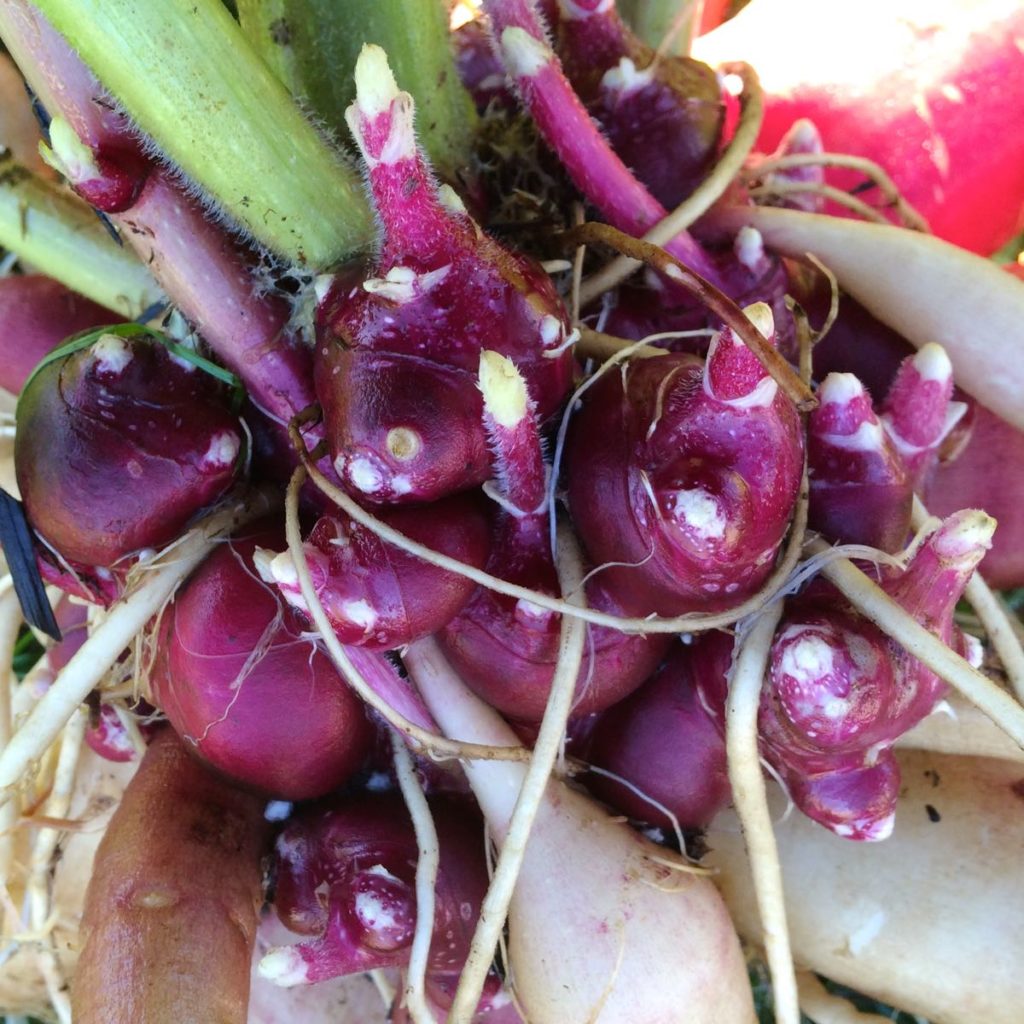
Yacon is a pretty easy and forgiving crop. It likes plenty of water, but it is not bothered by the heat of continental summers, so can be grown in North America anywhere that there is a frost free season of at least seven months. (That said, it is an Andean crop, so although it will tolerate a lot of heat, it yields best in milder climates.) It does need some protection from heavy winds, which will shred its leaves. A long, frost free autumn is ideal and will produce larger storage roots. Yacon grows well in both Hawaii and the milder parts of Alaska, which may give you some indication of how adaptable it is.
The optimum temperature for growth is about 65 to 77° F (18 to 25 C), but yacon tolerates temperatures as high as 104° F (40 C) as long as sufficient water is available (Polreich 2003). Dry conditions and wind reduce the maximum temperature that yacon can tolerate. In areas with very long summer days and favorable weather, like parts of Northern Canada and Alaska, yacon may grow up to twice as tall as the heights indicated in this guide.
Photoperiod
Yacon is not photoperiod dependent for forming its storage roots. There may be some influence on flowering, although I have seen a lot of early flowering among seedlings. It seems increasingly likely that yacon flowering may be entirely controlled by maturity, rather than day length, but it is too early to be certain.
Soil Requirements
Yacon is a heavy user of potassium and so benefits from fertilizers that are potassium rich. Organic sources of potassium include seaweed, wood ash, and greensand. It has only moderate nitrogen requirements, which are best served by making sure that your soil is rich in organic matter. Too much nitrogen can reduce root growth. The phosphorus requirement is fairly low and will generally also be met by soils that are rich in organic matter such as finished compost. Yacon tolerates a wide range of soil pH, but seems to perform best in weakly acid soil (6.0 to 6.5 pH) in my experience.
Propagule Care
Yacon can be started from rhizome or seeds, although seeds are uncommon.
Rhizome
Yacon plants are usually started from pieces of the parent plant’s subsurface crown of dormant rhizome. They store best in soil, but they aren’t particularly frost resistant, so it is best to keep them safely indoors until after your last frost. Although they may keep in a cool, humid environment until planting time, it is safer to pot them until you are ready to plant.
If you have purchased bare rhizome, check condition on receipt. If they are firm and have not sprouted, they don’t require any immediate care. More commonly, you will find that they have become a bit rubbery and may have sprouted while in transit. They can look pretty ugly if they have spent a long time in the mail, but don’t panic. Soak the propagules in room temperature water for about 8 hours (they should become firm again), then pot them in any potting soil with no added fertilizers.
Keep them under 50° F (10 C), if possible, until about a month before planting time; then, warm them up and give them some light. Yacon dormancy is not very strong, so the propagules may sprout during shipping if you live in a warm climate. Just pot them if you can’t plant them out immediately and put the plant where it can get at least some indirect sunlight. Transplant after your last frost. Plants with a few sets of leaves transplant better into cold, wet ground than dormant propagules do.
Seeds
Little is known about the proper storage conditions for yacon seed. They appear to have little to no dormancy and my best germination results so far have been achieved by planting seeds as soon as they are harvested.
Planting
Unless you are growing a large number of plants or live in a warm climate, it is best to start your yacon in pots before planting out. Yacon starts growing slowly, particularly in cool soil. You can give it a big head start by putting your pots on a windowsill about two months before your last frost. If you have too many plants for your window sills, a heat mat set to 65° F will do nicely. This should give you plants 6 to 12 inches (15 to 30 cm) tall, with three or four sets of leaves, by the time you are ready to harden them off and transplant. Yacon transplants pretty well as long as it is less than eighteen inches (46 cm) tall, after which it is likely to have become pot bound and will require a lot of cutting and loosening of the root ball in order to get it spread out so that it can produce a good yield.
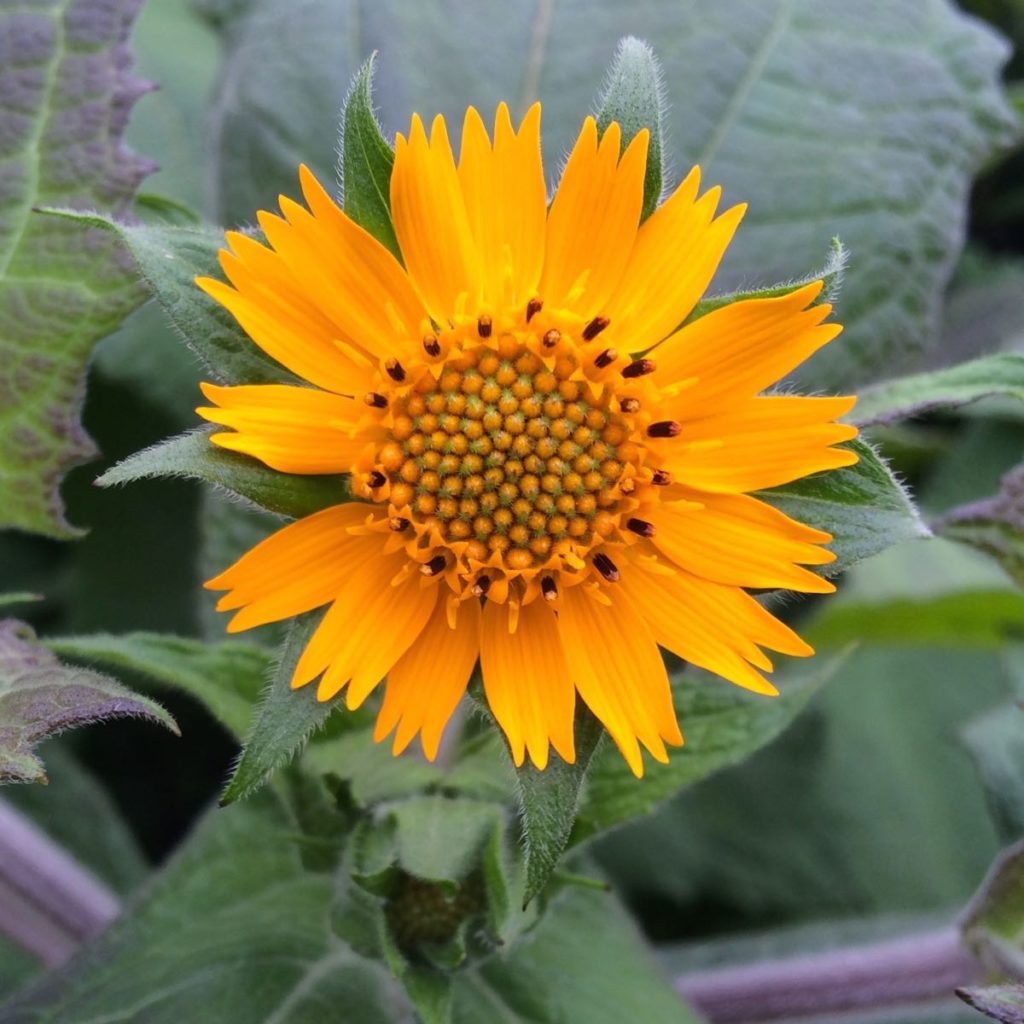
You don’t need to gamble on planting out when frosts are still possible. Yacon is particularly vulnerable to frost; it is typically damaged here even under very light frosts that leave other frost-sensitive plants undamaged. While it can recover from a light frost, it is going to take the entire season to form storage roots anyway, so there is no advantage to early planting, especially if you have started your plants in pots. Now would also be a good time to think about where to plant your yacon. If you have areas that are less prone to early frosts, planting there could extend your growing season.
I grow several hundred plants and start them all in four inch (10 cm) pots. Believe me, I wouldn’t go to the effort if it didn’t pay off. It makes a big difference in yield in our climate, which is a little bit cooler than ideal.
Yacon likes water and soil rich in organic matter. It doesn’t mind some heat as long as it isn’t allowed to dry out. It copes rather poorly with wind, so is best planted in a protected spot, or grown in a block where the outside plants sacrificially protect the inside plants. (Incidentally, that is also a good use for achira.) That is what I do here, where we often have wind storms in excess of 60 MPH (96 km/h) toward the end of the growing season.
The best planting depth for yacon rhizome is four inches (10 cm) (Tsukihashi 1996). Dig a hole or a trench four inches deep and place the rhizome piece at the bottom, cut side down, with the buds at the top. They form roots at the base of each bud, not at the bottom of the cut, so don’t allow the buds to protrude from the soil. If exposed, they will fail to root.
In row spacing of thirty inches (76 cm) works very well. Four feet (1.2 m) between rows will leave room to maneuver, but get pretty crowded by fall. In a study of yacon spacing in Korea, it was found that the tallest plants and largest roots were produced on a spacing of 32 x 24 inches (80 x 60 cm) (Ryu 2001). 32 x 24 inches was the largest spacing that they studied, so it is possible that even wider spacing could be better.
Management
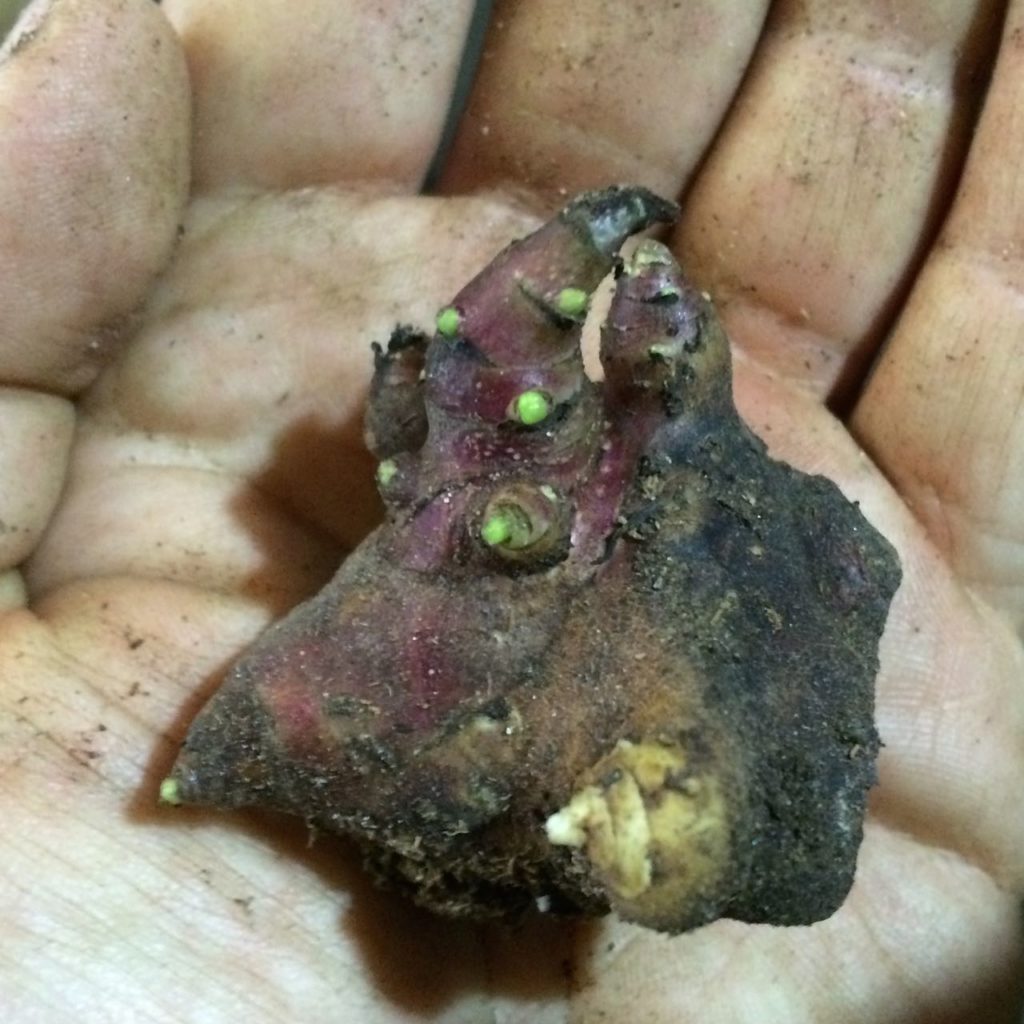
Yacon needs very little care once it is growing well. It is slow to establish early in the growing season, so weeding is critical. Once the canopy begins to close, weeds aren’t able to get the upper hand.
As the storage roots grow, some of them may protrude from the soil, particularly if the soil was hilled prior to planting. Coverage should be restored to prevent damage from slugs and other opportunistic pests.
In windy areas, you may need to stake taller plants to prevent them from lodging. When stems are blown down, they often break the rhizome and create an entry for water and pests. It is best to cut free the lodged stems and hill up around the base of the plant to protect the rhizome.
Companion Planting
Yacon is slow growing early in the year and it will take several months for the canopy to close and shade the ground underneath. This provides an opportunity to grow quick cropping annuals between. Many greens, radishes, turnips, and peas make good early season companions for yacon. We’ve also had good success sowing broad beans when the yacon is harvested in the fall; they mature just before the yacon overwhelms them the next year. You need pretty mild fall weather to be able to do this.
Yacon leaf matter appears to have suppressive allelopathic effects on some plants (Torres 2003). Seeds sown in close proximity to yacon or where it has previously been grown may have poor germination. In my experience, the effect is not particularly strong and I have no concerns about disposing of yacon foliage in compost.
Growing as a Perennial
Yacon is a perennial plant that is more often grown as an annual, since it is difficult to harvest the roots without pulling up the plant. Still, it is possible to grow it as a perennial in climates where the ground does not freeze more than an inch or two (5 cm) deep. This includes much of the maritime Pacific Northwest, coastal California, and the Southeast. In these climates, you can simply grow yacon in the ground for more than one season. The top will die back in a frost, and will ultimately die back due to natural senescence even in frost free climates, but the plant will sprout again when warmer weather arrives. The yield will increase significantly in the second year, and perhaps a little more in the third year. Second and third year harvests can be stupendous, requiring a wheelbarrow for a single plant.
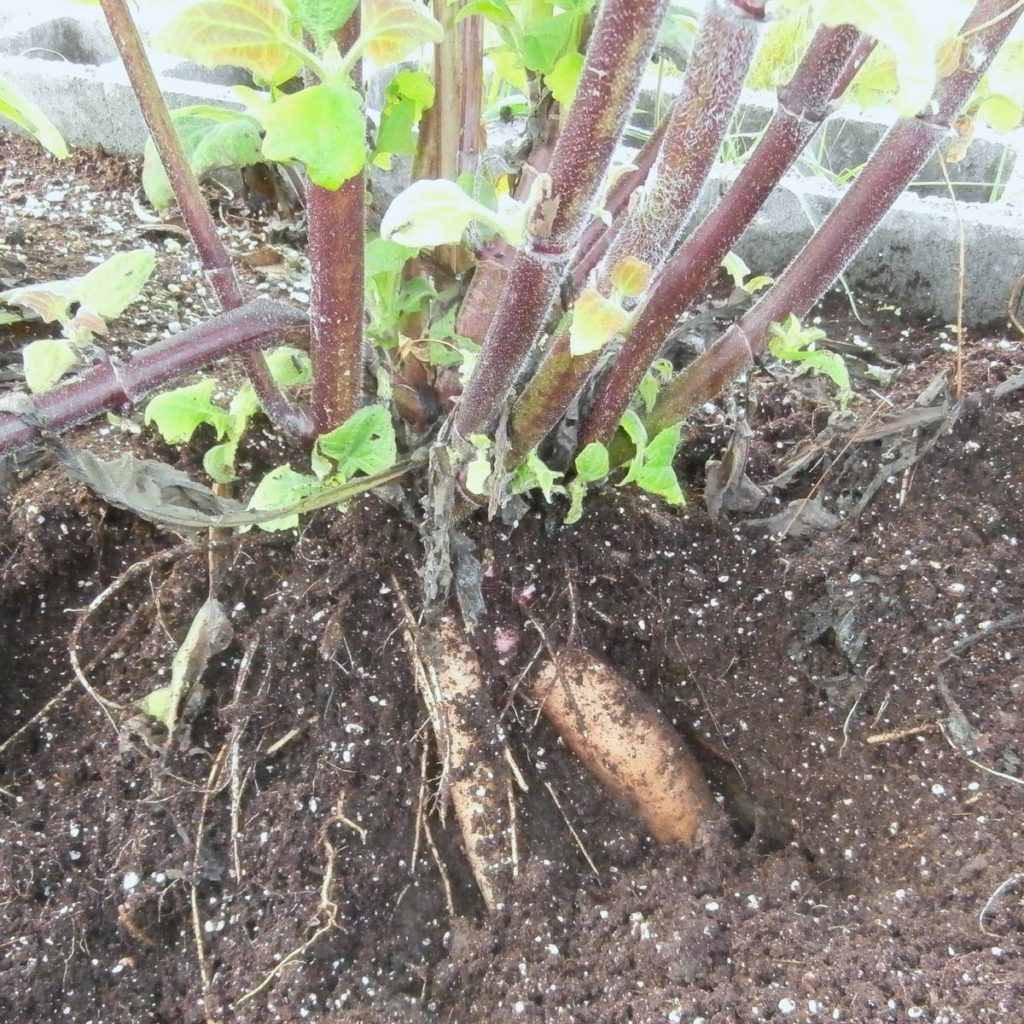
With some engineering, you can grow yacon as a permanent perennial, harvesting part of the crop of storage roots, but otherwise leaving the plant undisturbed. You can do this by growing the plant in a mound at least two feet tall, so that you can dig in from the side, underneath the rhizome to remove the storage roots. A concrete block bed works very well, because you can easily remove the wall on one side and then the other for greater access to the roots. Is all this effort worthwhile? You’ll have to decide that.
Container Growing
Yacon is a big plant and therefore needs a big pot. It is hard to imagine that it would produce a worthwhile yield in anything smaller than a half barrel, but I haven’t done any testing to confirm that. I have seen reports of poor yields from other growers who attempted to grow in smaller containers.
Harvest
In the Andes, yacon matures storage tubers in six to seven months of growth (NRC 1989). In the Pacific Northwest, it may need a little more time; I like to make sure that the plant has eight months in the ground.
There appears to be a widely held misconception that the proper time to harvest yacon is when it flowers. I guess this idea must have come about because one of the common varieties in North America, Early White, goes into senescence shortly after flowering. For that variety, the roots have grown about as large as they are going to by the time flowering starts. However, there are other varieties that have much longer flowering periods and they can continue to grow for a couple of months after onset of flowering. Yacon is very flexible about harvest. It needs about five months in the ground to produce a reasonable yield, but the roots continue to grow until the plant enters senescence, so you can be cutting yourself short by as much as two or three months if you harvest at the beginning of flowering.
We harvest our yacon around the end of November, or earlier if it was damaged by frost. Harvesting any time after the middle of October should give a reasonably good yield if the plant has been in the ground at least five months.
Unless you treat it like an archaeological dig, you can’t harvest a yacon without breaking a few roots. They are very brittle and snap easily when you pull the plant. I used to be more cautious about harvesting, but experience has taught us that we might as well man handle the plants since we break just about the same number of roots either way. I work around the base of the plant with a shovel, inserting it about 15 inches (45 cm) from the stem at a 30 degree angle and levering up. Once I have worked around the base of the plant, we pull it up by the stems. It is a good idea to have a helper, since there can easily be twenty to thirty pounds (9 to 14 kg) of storage roots, plus the weight of the soil clinging to the root ball.
Once the root ball is pulled, we remove the larger storage roots, leaving the small ones attached to the rhizome. Storage roots and rhizome clumps are sprayed clean with the hose and then left in the field to dry. In rainy weather, we dry them under tarps.
I recommend that you ignore your yacon roots for one month after harvest. During this time, they will increase in fructose content, which makes them sweeter. People often complain that yacon tastes bland when trying it just after harvest, unless the plants have been exposed to freezing temperatures. You can speed the process up a bit by exposing the roots to sunlight.
Storage
Rhizome
Yacon rhizome is best stored intact, with some small storage roots still attached. Trim stems back to no more than 2 inches (5 cm) and either shake free of dirt or spray clean with water. If the rhizome is wet, allow it to dry completely before putting it in storage. Yacon rhizome will mold if it isn’t dry. If the weather won’t cooperate with drying it out, put it in front of a fan indoors. Keep as close to 38° F (3 C) and 95% humidity as possible. If you can’t come close to ideal storage conditions, you can pot the whole rhizome ball in a large pot.
Storage Roots
Yacon roots store really well as long as they are unbroken. They have a respiratory rate similar to potatoes (Hermann 1997) and should last about as long in storage. Pack them away when fully dry, leaving out any that have breaks that are more than half the diameter of the root. At 50° F (10 C), these roots will easily last three or four months and often more if your storage conditions are humid. If you have the ability to cool them down to 35F (2C), they can last up to a year.
Broken roots don’t store as well. The simple solution is to eat those first. Even a badly broken root will typically last a couple of weeks before the broken end starts to mold badly. I have never found a moldy end to be a problem. Just cut back to clean flesh and eat the rest of the root. If you have a lot of broken roots, you can preserve them for longer storage by dipping the broken end in beeswax or other food safe wax. They will then store just as well as unbroken roots.
Preservation
The most common ways of preserving yacon are drying it and reduce it to syrup. It is probably possible to can it using instructions for low acid vegetables, but it seems like a lot of work, since roots can be stored for up to a year in the refrigerator.
Yacon can be frozen, but turns mushy and brown when thawed out, so this is generally not useful. It can be used as a frozen treat. For example, you can try cutting it into rectangles and inserting popsicle sticks for a summer snack.
Propagation
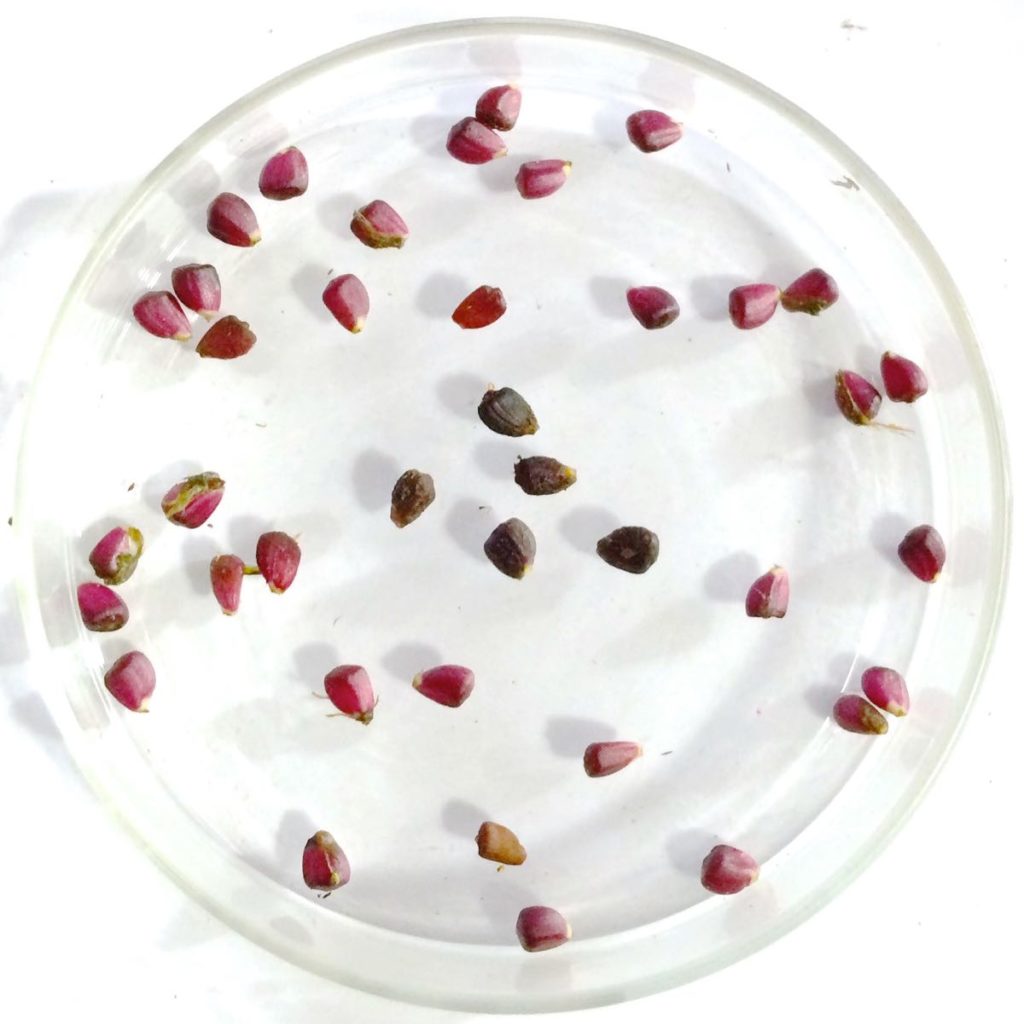
Yacon is primarily propagated by rhizome, although propagation from seed is possible for those wishing to breed new varieties.
Vegetative Propagation
Yacon forms two types of storage organs: large storage roots that you eat and a crown of rhizome that you can cut or break into many propagules in order to start new plants. It is not unusual to get 20 or more rhizome propagules when cutting up a yacon crown. It is best to break up the crown into pieces of not less than half an ounce (14 g), with at least two growing tips. I have found that five growing tips produce the best results here, but this won’t necessarily be the case in every climate. The smaller the propagule, the more vulnerable it is to desiccation and decay. There is an art to breaking up a yacon crown, as you want to maximize the amount of protective skin on the propagule and minimize the amount of interior flesh that you expose. Often this is easier said than done. Expect to lose a good number of the chunks that you cut, but you’ll get the hang of it before long.
Research by the New Zealand Institute for Crop and Food Research found that the best production is achieved with propagules of about seven ounces (200 g). At seven ounces, they achieved a yield of eleven pounds (5 kg), versus a 4.4 pound (2 kg) yield at 1.8 ounces (50 g) and a 13.2 pound (6 kg) yield at 18 ounces (500g). Seven ounces looks like the sweet spot, although if you have more rhizome than you know what to do with, which is often the case, you might as well go to 18 ounces and get that extra two pounds (1 kg) of roots.
For storage of propagules over the winter, I have found the following to be the best practices:
- Don’t cut up the crown until you are getting ready to plant. This only serves to dehydrate the pieces faster.
- Don’t remove all of the storage roots from the crown. Leave some of the small ones attached. This greatly improves storage life.
- Store the crown in dry sand at about 40° F (4 C), or as close to that as you can get, but do not allow the temperature to drop to freezing. If the crown gets wet, it will either sprout or rot, neither of which you want to happen in storage.
Crowns can last about six months under the recommended storage conditions. The storage roots (the part that you eat) will often last for nine months and perhaps longer with careful storage.
Yacon can also be propagated by cuttings taken before the onset of flowering. I like to use cuttings with three nodes, with the lowest node below the surface of the growing medium. A study of rooting in various media, including potting soil, sand, vermicompost, and various mixes of the three found no difference in cutting survival, but rooting proceeded most quickly in pure sand (Angayon 2008).
You can also divide propagules to produce more plants. This generally results in smaller, lower yielding plants, but provides more propagation material for the following year. Propagules should be planted in shallow soil and the sprouts cut free below the point where they root. This is not recommended if your main goal is to harvest storage roots.
Sexual Propagation
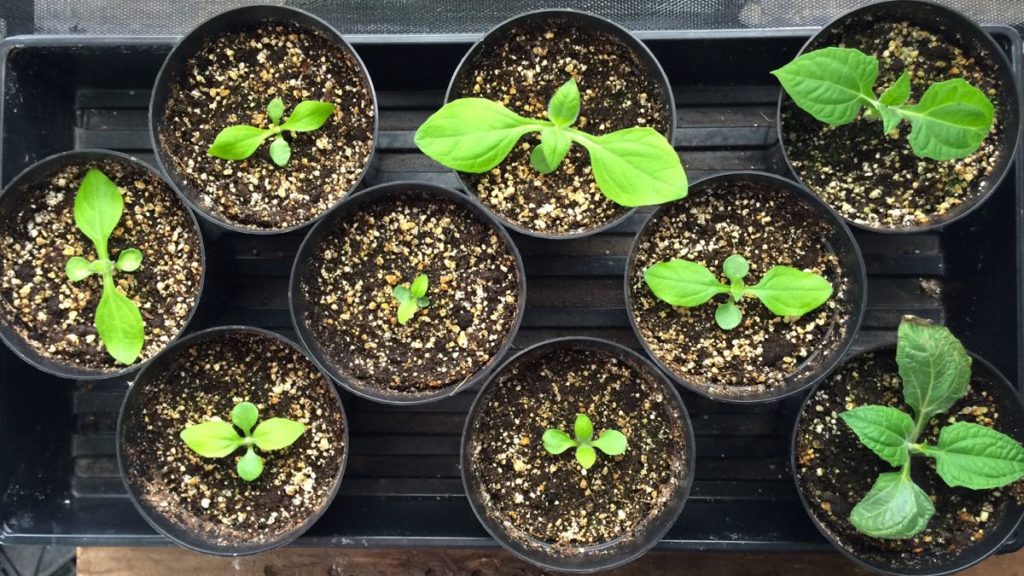
Until just a few years ago, yacon seed was very rare. In addition to their scarcity, the seeds that did occasionally form had an extremely low germination rate. These two traits conspired to make yacon breeding an impossibility. This has now started to change. The primary reason for this appears to be that collectors eventually amassed a large enough number of varieties to ensure that those that produced a little fertile pollen would be in flower at the same time as those that were capable of forming seeds. Our original crosses between those heirloom varieties produced about one seed per flower head and gave about a 10% germination rate. The varieties grown from those original crosses have now gone on to produce seed and have done so abundantly, yielding 10 or more seeds per flower head in many cases. This appears to be a full restoration of fertility in just one generation and bodes very well for the future of yacon breeding. I expect that saving and growing yacon seeds will be commonplace in just a few years as more people grow our new varieties and start their own more fertile plants from our seeds.
It appears that the primary reason that the second generation plants set so much seed is the production of abundant fertile pollen. Yacon shares a gene sequence with sunflower that has been determined to result in cytoplasmic male sterility (Mansilla 2019). The heirloom varieties produce very little pollen. When I pollinated the heirloom variety New Zealand with mixed pollen from seedling plants, the number of seeds per flower head increased from 2.9 to 7.8. Similar results occurred with Bekya. Morado, on the other hand, continued to set only a very small number of seeds, so low pollen production is not a complete explanation for yacon’s poor fertility. Other possible explanations for the improved seed set include earlier flowering of some varieties (which moved flowering into a warmer, drier time of year, which may have made pollination easier) and a larger population of insect pollinators (control plants still set fewer seeds than those that I hand pollinated, but more than they have set in previous years).
I’m much more optimistic about the possibilities for widespread yacon breeding than I am for most of the Andean roots and tubers. I have sold tens of thousands of oca seeds, for example, but this has only slightly expanded the climate range in which the plants will produce seeds. Ulluco remains so difficult that I can barely manage it and it seems unlikely that this situation will change very quickly. Even the humble potato sets seed reluctantly in continental climates. Yacon, on the other hand, has always flowered pretty readily anywhere that the season is long enough. Although untested, as yet, it seems likely that yacon will produce seeds in much of the temperate world.
Growing Yacon from Seed
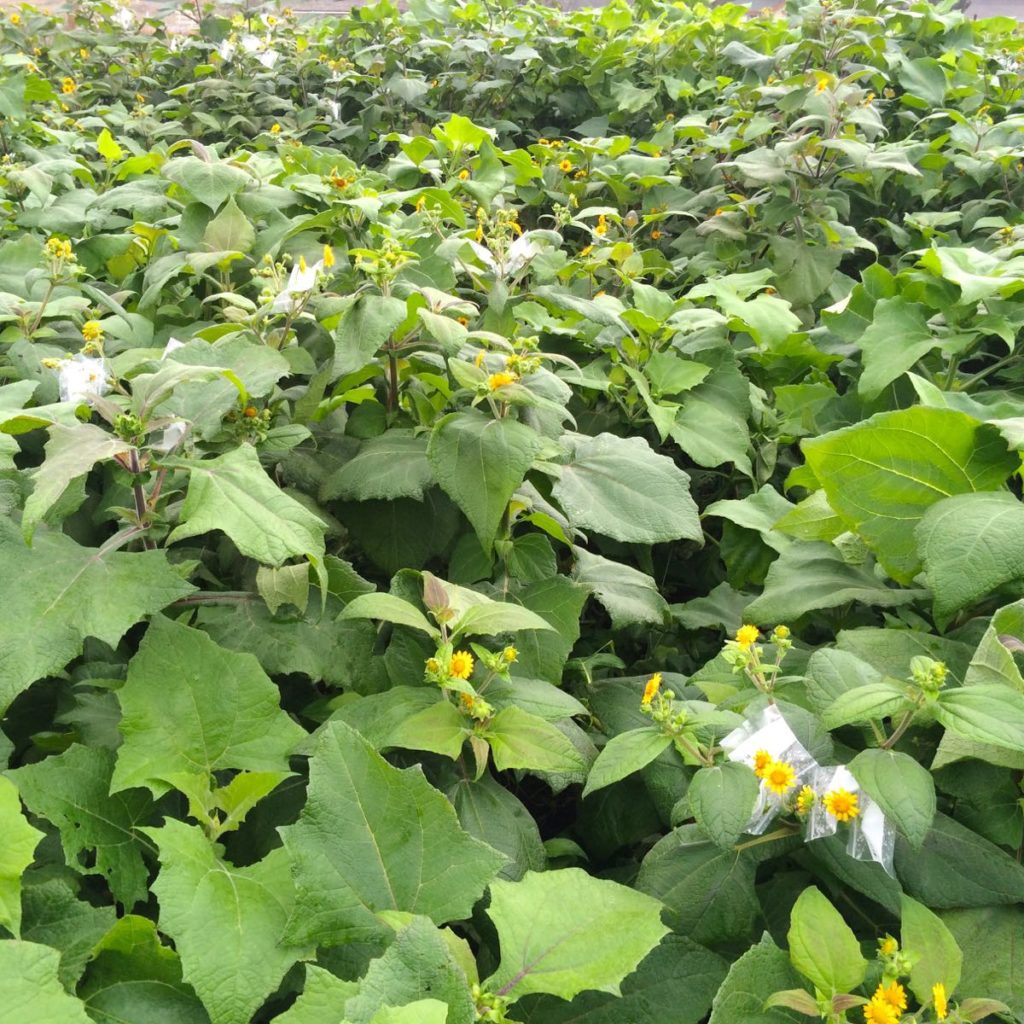
Yacon is polyploid, so like the potato, the results from seed will be quite variable and may not always be worthwhile. Genetic diversity is pretty low in yacon and particularly so among the small number of varieties that are available outside South America. So, you should not expect the same kind of incredible variability in traits that you get from potatoes or oca, but each new plant from seed is still unique.
Yacon seeds suffer from poor germination. In part, this is due to hard coat, so you can improve germination by scarification. With an acid soak, filing, or similar treatments, germination rates as high as 40% have been achieved (Manrique 2014), although my results are closer to 12%. Well, I’ll keep working on it!
I have had the best results germinating yacon seed in a flat on a heating mat set to 90° F (32 C) in very wet soil, after rubbing the seeds on sandpaper. You don’t want to sand them too much – rubbing a seed just once across about two inches (5 cm) of sandpaper seems to be sufficient. If you get too aggressive, you will sand through the seed coat and damage the contents. I plant the seeds about 1/2 to 1 inch (1 to 2.5 cm) deep. Some seeds germinate in just a few days, while others still take months. This kind of irregular germination is a signature of plants that have not been bred to be grown from seed. I recommend that you keep trying to germinate yacon seeds for two years. Although most germinate in the first two months, we have had some come up after 18 months and it is possible that more will continue to germinate.
Carefully transplant each seedling soon after it emerges. Grow them in small pots with slightly moist soil. Daytime temperatures of 70 F (21 C) and nighttime 50 to 60 F (10 to 15 C) work well. Grow them indoors under strong lighting until they have at least three sets of true leaves. Then they are ready to be hardened off and transplanted to their permanent growing location.
Saving Yacon Seeds
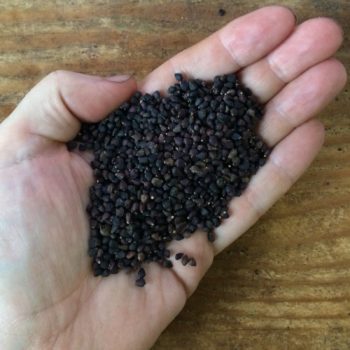
Yacon is an outbreeder (Hermann 1997), so you must have at least two different varieties in order to produce seed and those varieties must have some overlap in flowering period. Some varieties flower very late and will only be useful for seed production in areas with very long growing seasons. I have seen flowering onset in different varieties ranging from 149 to 264 days, with the average at about 200 days, but we have a very cool climate and the number of days to flowering may be lower in warmer climates.
You also must have varieties with compatible chromosome arrangements. Yacon is hypothesized to be an allopolyploid hybrid of two species, one with a basic chromosome number of 7 and the other with a basic chromosome number of 8. The probable parent species are S. macroscyphus (7 chromosome, A genome) and S. riparius (8 chromosome, B genome), with the former being the major genome contributor. Two configurations exist: octoploid (58 chromosomes), with six copies of the genome of one parent and two copies of the other (AAAAAABB), and dodecaploid (87 chromosomes), with nine copies of one parent’s genome and three of the other (AAAAAAAAABBB) (Hermann 1997). Because the chromosome configuration of the dodecaploid cannot be divided into whole numbers, normal meiosis is impossible and the dodecaploids are unable to reproduce sexually without extraordinary intervention. The dodecaploids are probably produced just as triploids are from diploids, as the fusion of a normal octoploid gamete (3+1) and an unreduced octoploid gamete (6+2), resulting in the dodecaploid (9+3). Most of the varieties that I sell are octoploids, but I suspect that Late Red is dodecaploid.
The varieties Bekya and New Zealand appear to be the best pairing for seed production, as their flowering periods are fairly close and each is capable of pollinating the other. This may not hold true in every climate. Of course, the fact that this cross is easiest may make it the least desirable. There will be greater value in getting crosses out of the more difficult varieties, particularly since the progeny seem to be much better seed producers than the parents.
Of the heirloom varieties, I have obtained seed and seedlings from Bekya, Cajamarca, Morado, and New Zealand. So far, Early White, Late Red, Dimy, Rose, Blanco, and Rojo have not produced seed, although they may have acted as pollinators in some of our varieties.
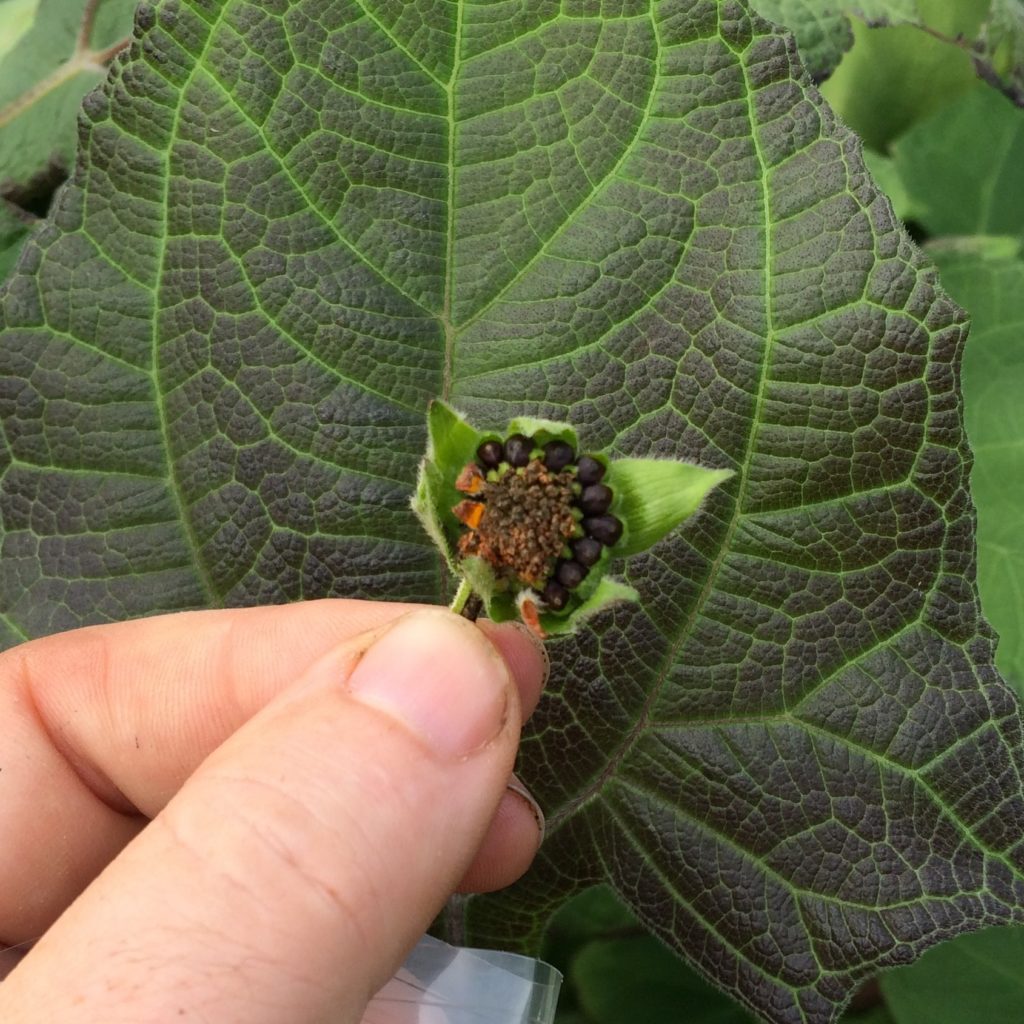
Yacon flowers always produce a full set of empty seeds even when there has been no pollination, so don’t get your hopes up too high if you observe seeds forming. The easiest way to tell if you might have a viable seed is the pinch test. If you can rupture the seed by pinching it between your fingertips, it is not viable. Viable seeds will be hard, brown or black, and will have a rough coat. You can check for any that are filled by soaking them in a glass of water for 24 hours. The seeds that sink are probably full and may be germinable. This step is probably only needed when saving seed from the heirloom varieties. Our new varieties produce abundant viable seed with few empty shells.
Few insects seem to be interested in yacon flowers. Here, there is a great deal of hover fly activity and a small amount of bumble bee activity, but little else. If you want yacon seeds, you will probably need to hand pollinate. This is easy to do – just collect pollen with a small brush and transfer it to the stigmas around the outside of the flower head. These are positioned at the base of each ligule – the yellow “petals” of the flower heads. The tricky part is finding the pollen. Most of the heirlooms produce very little pollen. If you start from seeds or grow our new varieties, you should find pollen much more plentiful.
Weather is another factor in the production of yacon seed. Here, seed set declines in November, even as the plants continue to flower abundantly. This occurs for both hand pollinated and open pollinated flowers. There are two likely reasons for that: pollen is less mobile at lower temperature and higher humidity and insect pollinators tend to fly less in cool, rainy weather. When attempting to save yacon seed in a climate with cool and rainy fall weather, plants should be started indoors in February or March and transplanted out once daytime temperatures reach 60 degrees F in the hope of bringing flowering into August and September.
It takes about 3-4 weeks from the opening of the flower head to mature seed, or roughly two weeks from when the flower is spent and has no more live florets. I have found it most convenient to bag each spent flower in a small resealable plastic bag. I then remove the bag and the flower when I see loose seeds in the bag.
There are approximately 98 yacon seeds per gram for mixed varieties. Individual varieties may vary by as much as +/- 30 seeds per gram.
Pests and Diseases
Pests
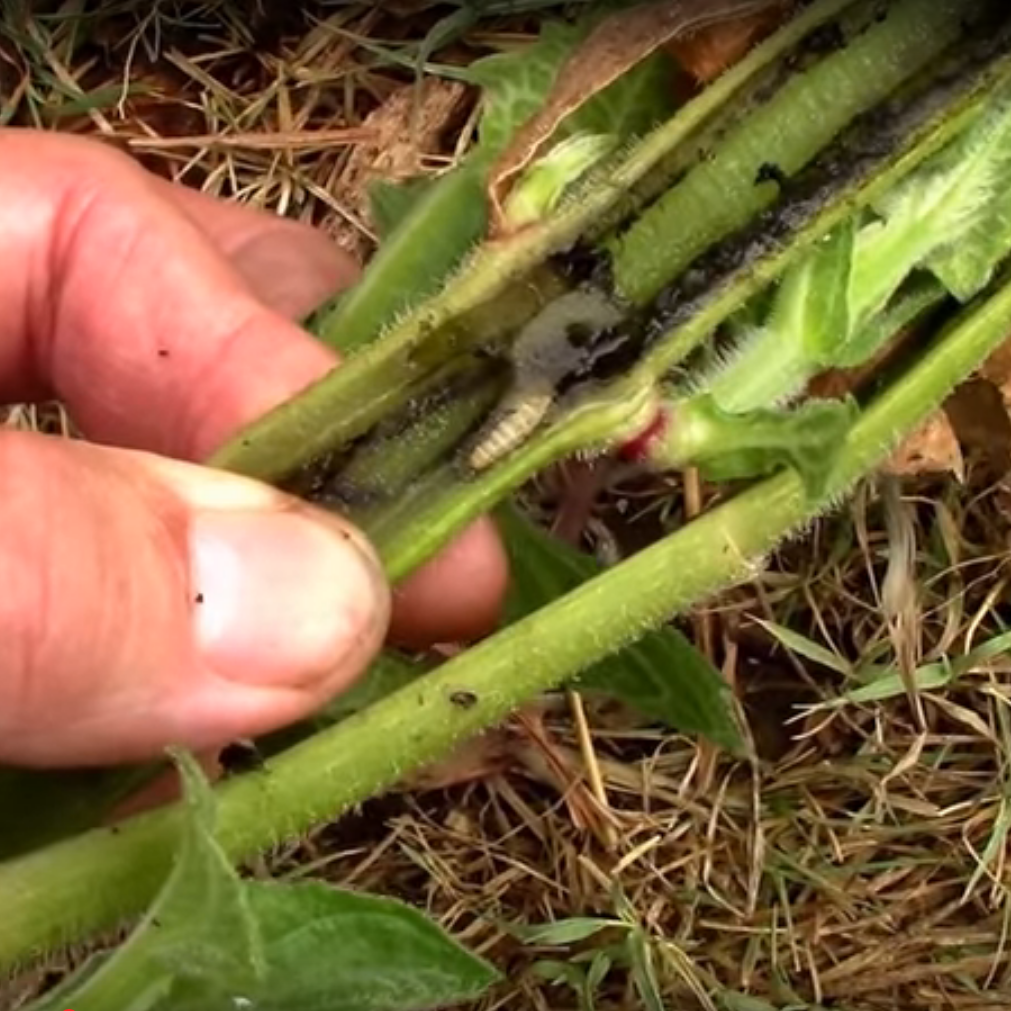
Yacon foliage is attractive to many pests, including slugs, caterpillars, waterfowl, rabbits, and deer. The insects are usually manageable and their presence will be obvious due to the many holes that they make in the leaves. We often see a major infestation of woolly bear caterpillars in early fall. Deer will browse yacon. They usually don’t do widespread damage, but I occasionally find a plant that has been stripped back to the stem. Field mice (voles) can be a problem late in the season, when they sometimes dig up and eat the rhizome. They don’t seem to cause any damage to the storage roots.
Some type of stem borer has been reported to damage yacon (Midwest Gardener 2017). This has now been identified as the sunflower root moth. Another possible candidate was the sunflower stem borer (Dectes texanus), also known as the soybean borer. This was first reported in Kansas, which is not too surprising since sunflower family pest diversity is high in the Midwest and East. If you are located east of the Rockies and see sudden wilting in yacon in the presence of sufficient soil moisture, check for holes bored in the lower part of the stem. A larva enters the stem and consumes it from the inside, eventually killing most of the upper part of the plant. This pest can probably be avoided by delaying planting until late June. That should not cause any problems with yield in a warm climate.
Diseases
Yacon is subject to a fairly wide variety of common diseases, such as cucumber mosaic virus, aster yellows, wilts caused by Pseudomonas and Erwinia spp. (Hermann 1997), and some fungal diseases like mildews.
Bacteria and Fungi
Rhizoctonia causes lesions, followed by a black rot under the skin of the storage roots in Brazil and probably elsewhere (Fenille 2005).
When establishing yacon in tissue culture, there is almost always a halo effect, which is characteristic of bacteria streaming from the cut. This effect is often very strong. This appears to be an indication that yacon is typically infected by bacteria, perhaps pathogenic, endophytic (symbiotic), or both.
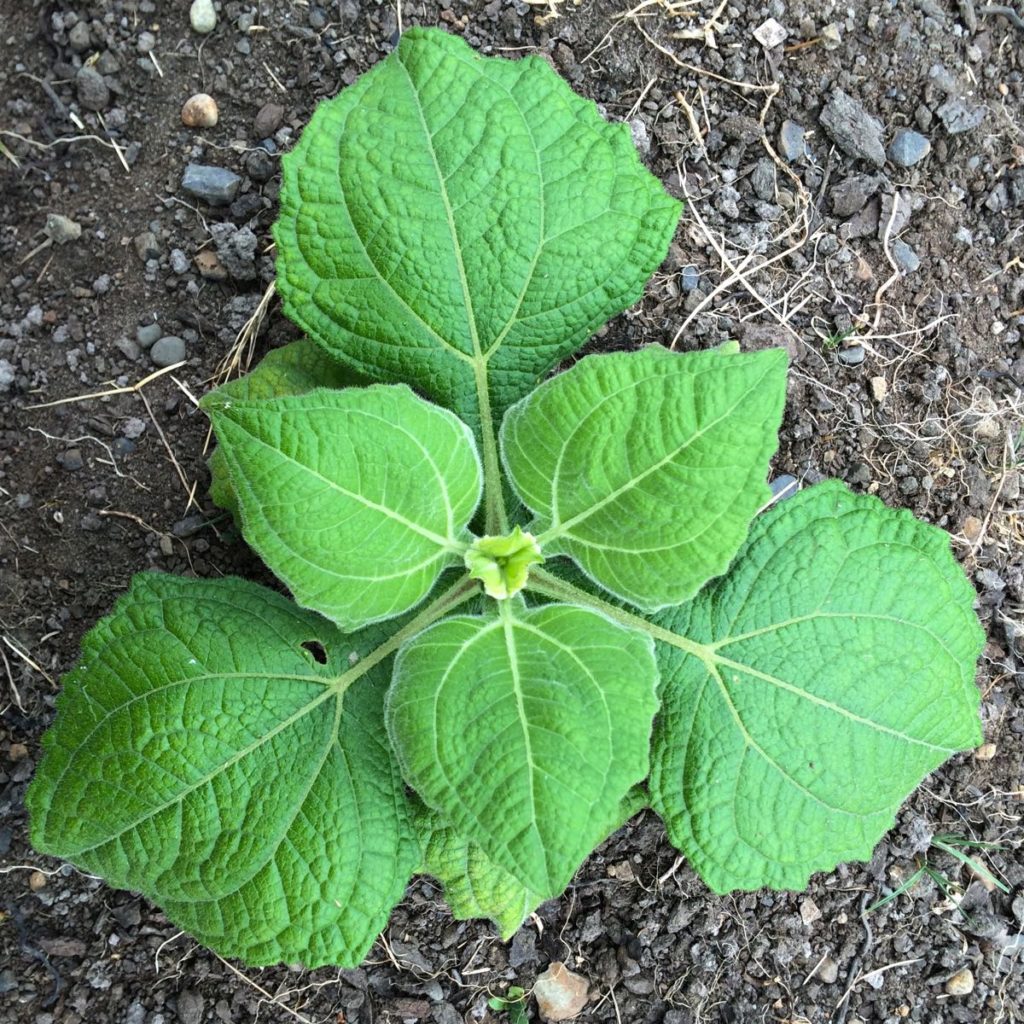
Viruses
Cucumber mosaic virus can become a serious yield problem and infected plants are best removed and destroyed immediately. It is probably wise to keep yacon separate from closely related sunflowers and Jerusalem artichokes. Jerusalem artichokes particularly could serve as a reservoir for common diseases since they are replanted from tubers. The main symptom that I have seen in infected plants is large yellowed outer sectors of older leaves.
Some viruses have been recently discovered and are apparently widespread in yacon. A virus that has been described both as Fragaria chiloensis Latent Virus (FClLV) and Potato Yellowing Virus (PYV) was found in plants in the EU and, since the varieties of yacon in NZ, the EU, and the USA appear to be largely the same, it would not be surprising if this virus is widespread. Because PYV also infects potatoes, it will likely be taken seriously, but I’m not sure what the response will look like considering that yacon is so widely grown. (On the other hand, FClLV is endemic in the USA, so maybe it isn’t a big deal.) Presumably, the focus will be on identifying and displacing infected sources with clean. I no longer grow heirloom yacons in order to hopefully eliminate the risk. FClLV and PYV are Ilarviruses, a group that is usually mechanically transmitted, which means that there is probably not a huge risk of crossing into potatoes, since they are not crops that would typically be grown together, but yacon varieties might infect each other if they come into contact. For that reason, you might want to space yacon varieties to keep them from coming into physical contact. The strain of PYV found in yacon has been confirmed to infect potato, but apparently with low efficiency. Unfortunately, it appears that Ilarviruses often transmit through seed, so that may not be a way to escape this virus, necessitating laboratory cleanup of infected varieties. Symptoms of PYV in yacon have received little study, but it may cause deformation in newly formed leaves.
Yacon Necrotic Mottle Virus was also recently discovered in South Korea and the EU. I would guess again that it will probably be found wherever yacon is grown. It is a Badnavirus, a group of pararetroviruses that can incorporate into the host genome, so it will likely be difficult to eradicate. Despite this, it doesn’t appear that Badnaviruses typically transmit through seed, so that may be a way to get clean varieties. The symptoms are yellow mottling accompanied by twisting and malformation of the leaves. I haven’t seen that complex of symptoms, but keep an eye out for it.
I haven’t done any testing for these new viruses because I didn’t know about them and they belong to groups for which immunological tests are not yet available, but I will have our varieties tested professionally in the future.
In 2019, I noticed that plants of one variety that I was propagating had slight leaf malformations in the new growth. I tested those plants for a selection of common viruses for which we have had field positives before and got a hit on Tomato Spotted Wilt Virus.
| Virus | Genus | Endemic in North America | Frequency in Yacon |
Seed Transmitted |
| Cucumber Mosaic Virus (CMV) | Cucumovirus | Yes | Uncommon | Possibly |
| Potato Yellowing Virus (PYV) / Fragaria chiloensis Latent Virus (FClLV) | Ilarvirus | Unknown (Probably) | Unknown | Possibly |
| Tomato Spotted Wilt Virus (TSWV) | Tospovirus | Yes | Rare | Unknown |
| Yacon Necrotic Mottle Virus (YNMoV) | Badnavirus | Unknown (Probably) | Unknown | Unknown |
Defects
Yacon has few problems. Flowers are sometimes malformed and fail to open. A mutation sometimes appears that produces leaves in sets of three rather than two. It doesn’t appear to have any effect on yield.
Crop Development
Unlike the rest of the Andean root and tuber crops, yacon does not have any particularly serious challenges to cultivation in North America. This makes goals for crop development less obvious. It is reasonably tolerant to heat and drought. It has high yield. It is resistant to common sunflower family diseases. Nevertheless, there is always room for improvement.
Improved frost resistance would increase yield in areas with a short growing season, as would earlier storage root formation. Shorter, bushier varieties are more resistant to wind, while tall varieties tend to lodge. Greater variety in skin and flesh color is appealing at market. Earlier flowering and improved seed set would facilitate further breeding. Greater fructose content could reduce or eliminate the post-harvest storage period that is required to sweeten the roots.
The storage roots of many varieties split in wet soil, so breeding varieties that resist splitting would be a worthy goal. Shorter, rounder storage roots would be less likely to crack during harvest. Improving both traits would reduce spoiling during storage.
Yacon has several close relatives that may be suitable for hybridization. Cross breeding with wild relatives may be particularly valuable because genetic analysis of yacon accessions have shown a low degree of variability between varieties (Svobodova 2013). Hybrids of yacon with Smallanthus riparius have probably already been achieved (Smith 2010, Sep 27). Smallanthus macroscyphus and S. connatus also seem promising for hybridization (NRC 1989). I have seen seed formation on S. maculatus following hand pollination from yacon flowers, although none of the seeds have yet germinated. There may be other members of the genus Smallanthus and perhaps the genus Polymnia that are suitable for breeding with yacon.
Relatives
Smallanthus is a fairly large genus, with twenty-three species in the most recent treatment. It may be possible to cross some of them with yacon to introduce new traits. This is likely to be a long process, since few members of the genus have significant storage roots as yacon does. Nevertheless, it is a common practice to cross edible plants to their wild relatives and then restore edible traits through a series of back-crosses.
Self-incompatibility appears to be consistent throughout the genus, so you need at least two different clones in order to obtain seed. Most of these species will not survive a severe freeze and don’t form crowns that are easy to propagate. They do propagate readily from stem cuttings as long as you take cuttings before flowering, so if you have cold winters, you should probably start some potted plants from stem cuttings in late summer and carry them through the winter indoors.
The best hypothesis to date posits a hybrid origin of yacon from a cross between S. macroscyphus and S. riparius with possible back-crossing. I’m not that confident in existing hypotheses about the origin of yacon, because they rely on the existence of x=7 (A genome) Smallanthus varieties. The proposed A genome contributor for yacon is S. macroscyphus, but there are conflicting chromosome counts for this species. If 2n=28 is not correct, then there doesn’t appear to be another likely contributor. The large number of different chromosome counts for both yacon and its wild relatives make the picture fairly confusing.
The following chart summarizes some information about yacon’s wild relatives. The green rows are in the “yacon group.” Yellow rows are the “glabrata complex” of woody shrubs and small trees. There have been no large scale genetic analyses of the genus, so groupings are based purely on morphology and chromosome counts. All entries with question marks are my speculation. Hopefully it will be possible to fill in the blanks some day.
| Species | Distribution |
Ploidy | x | 2n | Genome Arrangement |
References | Notes |
| S. apus | Mexico | 4x? | 8? | 32 | BBBB? | Wells 1967, Vitali 2015
|
Herb to 10 feet |
| S. cocuyensis |
Colombia |
? |
? |
? |
? |
Vitali 2015 | Herb to 10 feet |
| S. connatus
Yacon gaucho |
Argentina, Brazil, Paraguay, Uruguay | 4x? | 8? | 32 | BBBB? | Wulff 1984, Vitali 2015 |
Herb to 10 feet
Southernmost distribution, possibly = S. macroscyphus |
| S. fruticosus Colla, colla culapa, polaco, shita, shitadeloso |
Bolivia, Colombia, Ecuador, Peru | ? |
? | ? |
? |
Vitali 2015 | Shrub to 16 feet Used as herbal medicine |
| S. glabratus
Garita, poque, putaca, shita, taraca |
Bolivia, Peru |
4x? | 30 | AABB? | Carr 1999, Vitali 2015 | Shrub to 20 feet |
|
| S. jelskii Shita |
Peru | 8x? |
8+7? | 58 |
AAAAAABB? |
Vitali 2015 | Tree to 23 feet |
| S. latisquamus | Costa Rica, Guatemala, Mexico |
2x? | 16 | BB | Carr 1999, Vitali 2015 | Herb to 10 feet |
|
| S. lundellii |
Guatemala, Mexico |
? | ? | ? |
? |
Vitali 2015 | Herb to 3 feet |
| S. macroscyphus
Yacon del campo |
Argentina, Bolivia, Brazil, Paraguay |
4x? | 7? 8? | 28, 32 | AAAA? BBBB? |
Ishiki 1997, Rosenblum 1985, Vitali 2015 |
Herb to 10 feet
Proposed yacon progenitor, small storage roots |
| S. maculatus Ax, árnica, balim k’in, batzil, chocotorro, gigantón, gua-gua, ik’al, k’ail, k’ayil, margarita, mirasol, mirasol de monte, purca, tora, shti-pú, tz’ibal |
Belize, Costa Rica, El Salvador, Guatemala, Honduras, Mexico, Nicaragua, Panama |
4x? | 8? |
32 (66, 68) | BBBB? |
Wells 1965, 1967, Robinson 1981, Vitali 2015 |
Herb to 10 feet Used in herbal medicine and as detergent |
| S. mcvaughii |
Mexico | ? | ? |
? | ? |
Vitali 2015 | Herb to 16 feet |
| S. meridensis |
Venezuela | ? | ? | ? | ? |
Vitali 2015 | Herb to 6 feet |
| S. microcephalus Tucte |
Ecuador, Peru |
? | ? |
54, 60 | ? |
Robinson 1981, Vitali 2015 |
Shrub to 23 feet |
| S. oaxacanus Cambray |
Guatemala, Honduras, Mexico | 4x? | 8? |
32 | BBBB? |
Turner 1962, Vitali 2015 |
Herb to 7 feet |
| S. obscurus |
Mexico |
? |
? |
? |
? |
Vitali 2015 | Herb to 7 feet |
| S. parviceps Jareta, shita, wila-wila, yareta, yarit |
Bolivia, Peru | 8x? |
8+7? | 58 |
AAAAAABB? |
Jansen 1984, Vitali 2015 |
Herb to 23 feet Used as herbal medicine |
| S. putlanus |
Mexico |
? |
? |
? |
? |
Vitali 2015 | Herb to 5 feet |
| S. pyramidalis
Anime, anime manso, anime negro, arbolaco, arboloco, colla, (f)tajuash, polaco |
Colombia, Ecuador, Venezuela | 8x? | 8+7? | 58, 60 | AAAAAABB? AAAABBBB? |
Carr 1999, Heiser 1963, Hunziker 1989, Vitali 2015 |
Tree to 33 feet Used as herbal medicine and as ornamental plant |
| S. quichensis Arnica, carricillo |
Costa Rica, Guatemala | ? | ? | ? |
? |
Vitali 2015 | Herb to 10 feet |
| S. riparius
Colla, pailon |
Colombia, Costa Rica, Ecuador, Peru, Venezuela |
4x? | 8? 8+7? | 32, 30 | BBBB? AABB? | Ishiki 1997, Heiser 1963, Robinson 1981, Vitali 2015 |
Herb to 16 feet
Proposed yacon progenitor |
| S. siegesbeckia |
Bolivia, Brazil, Ecuador, Paraguay, Peru | ? | ? |
? | ? |
Vitali 2015 | Herb to 16 feet
Fairly large storage roots |
| S. sonchifolius | Argentina, Bolivia, Ecuador, Peru | 8x, 12x |
8+7 | 58, 87 | AAAAAABB,
AAAAAAAAABBB |
Ishiki 1997, Hermann 1997, Vitali 2015 |
Domesticated species |
| S. uvedalius
Bearsfoot, hairy leafcup, mirasol, paira, purca, xilil |
Belize, Costa Rica, El Salvador, Guatemala, Honduras, Mexico, Nicaragua, Panama, USA | 4x? | 8? | 32 | BBBB? | Wells 1967, Vitali 2015 |
Herb to 16 feet
Northernmost species Naturalized in Canada and Bermuda |
Smallanthus connatus
S. connatus, also known as yacon gaucho, is a wild South American relative of yacon that may be sufficiently compatible for hybridization. This is the least cold tolerant of the Smallanthus varieties that I have tried. Established plants appear to tolerate temperatures down to just above freezing, but seedlings have a difficult time with temperatures lower than 45F. It seeds readily, so plants are usually started from seed, although it can be propagated by stem cuttings in the same manner as yacon. It does not produce storage roots like yacon, but has somewhat thickened roots that are edible and taste a bit like yacon does before it is sweetened by frost or storage. The plants die back in a frost, but can overwinter about as successfully as yacon. I have obtained mature seeds from bidirectional crosses with yacon, but haven’t gotten any to germinate yet.
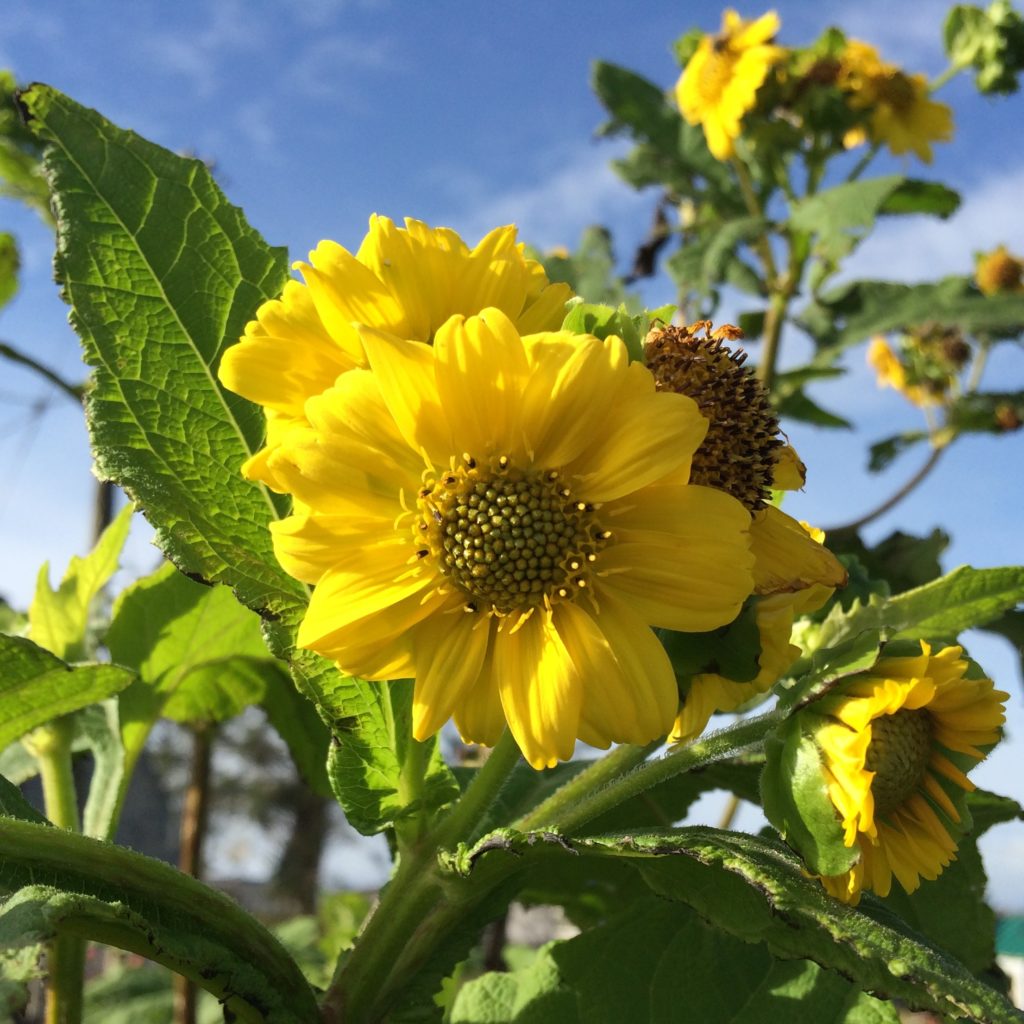
Smallanthus maculatus
S. maculatus is a wild relative from mountainous areas of southern Mexico and Central America. It appears to be compatible with yacon and will set seed when pollinated from yacon, although I haven’t gotten any of the seeds to germinate yet. S. maculatus is a tetraploid species, so it may be difficult to cross with normally octoploid yacon. As with most of yacon’s wild relatives, it doesn’t produce storage roots, but is typically propagated from stem cuttings. I have found that it cross pollinates successfully with S. uvedalius in either direction, with the only challenge being that there is little overlap in their flowering. This may allow bridging traits from S. uvedalius to yacon if only I can get some of the seeds to germinate. Plants die back in a frost. Some will resprout from the roots but others do not. This species does not overwinter as readily as yacon and will generally be killed at temperatures below 25 F.
Smallanthus riparius
S. riparius is the only one of yacon’s wild relatives that has been confirmed to hybridize successfully with yacon. Unfortunately, the hybrids appear to be sterile, but yacon is such a poor pollinator that it is possible that backcrosses will be successful with more attempts. I haven’t been able to find a source of seed, so I haven’t grown this plant yet, but I hope to find some and to try recapitulating the cross with yacon at some point. See the next entry for more information.
Smallanthus x scheldewindekensis
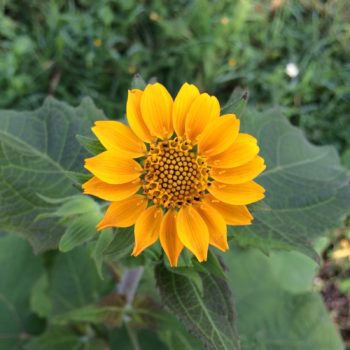
That’s a mouthful! This cross was originally made by Andean crop explorer, Frank van Keirsbilck in Scheldewindeke, Belgium. He pollinated the yacon variety ‘New Zealand’ with pollen from S. riparius with a high rate of success. The plants looked intermediate between the two species and, although S. riparius does not produce large storage roots, the hybrid produces reasonably large roots that taste similar to yacon. There is probably some reason to be cautious eating this plant. Since it is a first generation cross with a species that doesn’t have much history of edible use, there could be surprises. The biggest problem with this hybrid is that it is apparently sterile, failing to set seed when pollinated by either parent. I have collected a few mature seeds, but never from a flower than I crossed intentionally, so I don’t know what the pollinator was. Hopefully, at least one of those seeds will germinate and reveal its parentage by appearance. The most likely scenario for the cross that produced this plant is a 4x gamete from yacon and a 2x gamete from S. riparius, which would produce a 6x (hexaploid) hybrid. In the hexaploid scenario, the mix of genomes in the hybrid should be 4 x S. macroscyphus and 2 x S. riparius, yielding an AAAABB genome, changing the genome ratio from 3:1 to 2:1. If you want more information, this hybrid is covered extensively at the Radix blog.
Smallanthus uvedalius
The only member of the genus that occurs north of Mexico, S. uvedalius has a very large distribution, running from Panama north through the eastern USA almost to Canada. That makes it one of the few hardy members of Smallanthus and therefore a very attractive candidate for hybridization with yacon. My experiments and those of a few others have failed, but it hasn’t yet been attempted with any of our new, much more fertile varieties. A recent genetic analysis of the genus found that S. uvedalius is only a little more distant from yacon than S. riparius, which is known to hybridize successfully (Vitali 2014), so this is worth attempting again. As noted above, it does cross with S. maculatus, so there is the possibility of a very tenuous bridge between species.


You have sold out on everything you sell!! Nothing is available. Last year, I had to purchase yacon plants from Baker’s Creek. Would rather purchase oca, yacon (etc.) from a local source, not some large seed seller. Any suggestions on how I can do this? Do you have any extra tubers that aren’t sold out? I’m still growing oca from a tuber I purchased from you several years ago, but want to grow different variety.
We will open for sales in late Feb/early March. We should have plenty of oca, but no yacon this year. You can always see the current status here: https://www.cultivariable.com/status
Good Morning
We are looking for yacon rhizomes, we needed 10,000 units. do you have in stock?
Best regards
Pedro Paccetti
Hi Pedro. We cannot send yacon rhizome outside the US. Even if we could, 10,000 units is about the same as our entire annual production. Yacon multiplies at about 20:1, so if you can find 500 rhizome propagules locally, you would have enough for 10,000 next year.
If you are near Petaluma, CA I’ll give you some of my yacon corms from this year’s harvest. Grow one plant and you’ll have enough corms to cultivate forever.
Genie
eraff@ix.netcom.com
if i have a tubercule can i plant it too? Or its only by the rhizome? Thanks in advance
Anne, unfortunately the storage roots don’t have any buds, so they cannot sprout a new plant.
Thank you so much for your good information
I need your address.
I have a small lot but I would like to try one of these plants. Will they grow in the southwest?
You can find our contact info under About -> Contact in the menu.
Many people grow yacon in the southwest. It can handle the heat, but it isn’t drought tolerant, so it needs a regular supply of water.
I know yacon is related to Jerusalem artichokes, is it an aggressive spreader in-ground the way they are? Considering planting one tuber out and one in a container as an experiment. Thanks!
While Jerusalem artichoke grows from any piece of rhizome or tuber, yacon grows only from the crown, so it does not spread.
Fantastic article. Living in a zone 6 mountain climate in France with a short growing season, I feel a bit daunted, but hope to grow two plants this year. Thank you for this very thorough and well-presented information.
Thank you so much! I’m from Viet Nam. My country has this plan, but few
Miqueal, I’ve been growing yacon in upstate NY (USA) in zone 5, borderline 6 for several years now. You should do fine, just won’t get quite the yield as in warmer areas. Good Luck!
I’ve been growing in upstate NY for years Miqueal. (Zone 5/6) You should be fine, just not as big a haevest as warmer areas.
wir leben in Deutschland nahe an der Grenze zu Frankreich, und haben die Yacon schon viele Jahre erfogreich im Anbau, wer Knollen oder Rhizome benötigt, darf sich melden : waldi89@web.de
Dear Sir,
I’m from India, can I have some yacon seeds.
Regards,
Sunil Ware
Hi Sunil. Unfortunately we are out of stock. I expect to collect more yacon seeds this year though. When they are available, you will find them here: Yacon seeds.
I wonder if I take cuttings from that plant – does is produce well? Or does it take one more year to produce?
Cuttings take about 4-5 weeks to root. After that, they behave pretty much like plants grown from rhizome.
Would pruning or thinning out a plant, like a potato plant, produce more or bigger fruits?
Depends very much on the plant. In potatoes, I would generally say no. Usually they will mature all the fruits that they set. In drought, there might be some advantage to thinning them.
“This guide provides information about growing *ulluco* in North America…”.
Ulluco?
This phrase occurs on the page about yakon .
Ha! It is amazing how many times I edited this page and missed that. Thanks!
I’m expecting delivery of my first rooted cuttings in Sydney Australia. Any hints or ideas to
avoid disappointment.
Great article! Thanks
Just be patient and keep the small plants protected from anything that might chew them. They are slow to get established and attractive to pests. Once they get going, they take care of themselves pretty well.
We grow Yacons in Dorrigo NSW (Australia) in well mounded free-draining soil and yes, 12-15kg of plant (tuber and rhizome) is very common. We harvest from July through to October (and even into November) very successfully and have plenty for sale. We’ve found that the frost isn’t a deterrent – temperatures down to -6C, but NO snow. The leaves and stems generally die off after the first frost. (temperate zone) Regular watering is a must for tuber development, but we still get cracking. It’s the nature of the beast!
Hi I have grown six rhizome and a handful of seed of Yacon, I have been surprised how well the have both grow. I have grown them in 90 litre containers, organically. The Yacon plants grown from seed and flowering now (28th Sept 2019) the rhizome grown ones are a very healthy height of over five feet. My seed sown Yacon are four and half feet, however they do not look so robust as the rhizome grown ones. Is this normal?
That is normal. First year plants from seed have a slower start than plants grown from rhizome. They will likely grow larger next year when you start them that way. That said, seed is genetically diverse, so you are selecting new varieties. Relatively few of them are likely to be superior to the existing clones. Your odds are better with yacon than most crops though. I find that about 1 in 20 varieties grown from seed are equal or better than the existing clones and they are almost always much more fertile. The existing varieties are also largely infected with viruses and the seed grown plants are likely to be healthier, which also factors into the comparison.
I planted two yacón early this year, and while they are growing vigorously, they did not flower. I live in Republic, MO, in Zone 6B. Should I just leave them in the ground and wait for a harvest next year or the year after?
Most yacon varieties require a minimum growing season of seven months to flower, so a lot of people never get any flowering. Flowering isn’t important to harvesting the roots.
Thank you for your response. We had a mild frost last night and the leaves have turned quite grey. My question is: Should I leave them in the ground and wait for them to flower next year? Or should I try and harvest roots now?
There isn’t a right or wrong answer. They should be large enough to harvest now. They will also grow larger next year if left in the ground.
What a fantastic article. I am from Ontario, Canada. Do you mail seeds to Canada?
Unfortunately, no. Canada does not allow most of the crops that we offer.
I plan to grow yacon in one bed , this year 2 rows , next year 2 more leaving the first year plants untouched, the following year 2 more rows , then harvesting the first rows planted , then replanting in the vacated land , a 3 year rotating crop in one bed , will this cause any disease problems ,Thank you kev from nottingham uk .
I would like to plant some yacon varieties but can’t find anyone who has any. Please let me know if there are any.
Thanks
Yacon is harvested in late fall/early winter and shipped in spring. Some varieties are currently available for preorder:
https://www.cultivariable.com/product/yacon/yacon-varieties/yacon-bogachiel/
Hello.
I want to buy some Yacon rhizome.
When can I buy it?
What is available as preorders is all that is left at the moment. It has been a crazy year. With the virus, a bunch of people started gardening all at once. I don’t cut and ship the crowns until spring, so it is likely that there will be some excess available after that – probably end of March, beginning of April. I will announce it on our mailing list if so.
I am wondering if the leaves are safe to feed to chickens?
It is safe insofar as many people do it and it doesn’t have any apparent negative outcomes. I doubt that it has received any real study though.
Good to read this. Thanks for sharing.
I would love to see the cost-benefit analysis of the production of yacon tubers. Do you have any data on cultivation cost, production, and gross/net profit per unit of land?
I think that information would be very specific to market. Most people who grow yacon in bulk do so for processing into syrup or dried products and the cost/benefit will depend greatly on what capacity exists for this. Selling yacon as a fresh product is difficult outside of major city markets as people are not familiar with it.
I bought a yacon on amazon 3″ baby plant, looked like a rooted cutting, and after harvest have propagated about 30 plants from that first rhizome. I am now about to harvest the 30 mature plants that are over 2 meters tall and flowering. Based on what you described, I will not have any viable seeds since I only have one type. How do I know which type I have, so I can buy a different type from you from seed. I’d like to get seeds of my own and hope to get a new unique type in the future.
Based on your pictures, I believe I have Kalaloch. Color is evenly light brown and inside is white. Why is the picture for Dosewallips and Wynoochee the same? I’m interested in trying one of the red varieties, but Bogachiel looks like very large yields. My Kalaloch had a very large yield and large tuber the size of my forearm the first year. It’s hard to tell when to harvest in CA since they don’t die back. Based on your suggestion, I’m tempted to leave some for 2-3 years since you mentioned higher increases in yield.
It is unlikely that you have one of my varieties, since most people who sell unnamed yacon sell one of the heirloom varieties. Odds are that you have either Early White or Cajamarca, since those tend to be the most common unlabeled yacons. Neither one is of much use for producing seed, unfortunately, possibly because they are very late flowerers or possibly because they are overwhelmingly virus infected. As long as you can get them flowering at the same time, though, any two varieties at least have the potential for setting seed.
Hi from Germany where I grow 11 different varieties of yacon. Because of voles I grow it in pots of 60 or 90 litres and get an average yield of 10kg per plant. For storage after the frost in October I just put those containers in the cool basement at 10 degrees celsius. As a graduated biologist/agriculturalist and professional gardener I test the new very sweet varieties from a breeder in
Belgium (www.yacobat.be) which have a good storage quality.
haben sie auch gelbfleischige knollen in belgien gefunden ?
My second year was better compared to last year’s failure.
2022 I got the plants from a local supplier since you can’t ship to here in Canada – unspecified variety but they have green stems, tan skin and white flesh. They shipped a bit later than ideal and then took a long time to get established and got overgrown by neighbouring plants in the vegetable garden (mainly tomatoes) so they weren’t getting enough light and the plants ended up rather small (4-5ft, 1-3 stalks). The plants I received also seemed small, started from probably just 1-2oz of rhyzome, and came in a small 2″ container. The harvest ended up being just a few ounces per plant. They were in the ground June 3-Nov 14.
I think I wasn’t careful with how to store the crowns (which were small, just a few ounces) because several of them seem to have rotted, so I only had 4 sprouts, which I divided up into separate plants. They started to sprout in early April, and I had them in 6″ pots which I planted June 14 in full sun this year. I was moving to a new house so I couldn’t plant them earlier, although late May is the earliest I can do since we have a risk of frost before then. They grew well, about 6ft tall, with 6-12 stalks per plant, and 2-3ft spacing. Wind isn’t bad here, typically 40-45mph is our strongest gust in a growing season, with the windiest day having sustained winds of only 20-25mph. Just harvested them today after a 27F frost – I added some extra mulch to the base of the plant before the frost so the crown wouldn’t get damaged.
With just 4 months and 8 days in the ground, I nonetheless got a yield of 7-13 lbs per plant, which I’m pretty happy with. The crowns seem very large and healthy too, the biggest one is 4 lbs, the other two are 1.5-2lbs. Since I just have a suburban yard and grow other things too, I’m not looking to propagate any more, 3 plants should be enough for now, so I suppose I can just store the crown as is, and then plant the whole crown as a single plant? That way it can hit the ground running in June and give a higher yield per plant? I suppose I’d have to store them in a large 2-5 gal container of dry soil and plant it out of that to avoid it becoming root bound?
Our average late frost is around May 15, with a slight risk of frost as late as May 25-30, and average first frost Oct 12 (we were lucky this year – 10 days late), so I think with a short growing season like that, I need to do everything I can to give the plants a boost. Fortunately our weather in those 4.5 months is good – no strong wind, steady rain, days in the 60s-80s, nights in the 40s-60s, and nutrient rich soil (clay, but I’m amending with a lot of organic so it’s easier to dig), and long days, 15 hours in June-July.